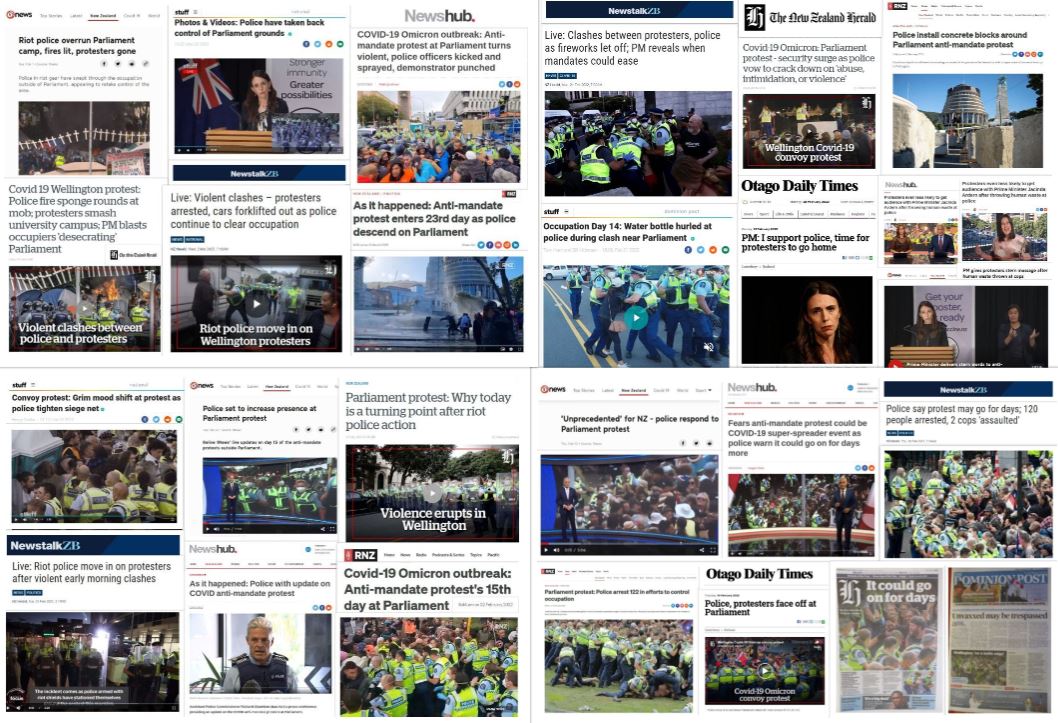This heretical dispatch focusses on four key dates when New Zealand’s Police brought violence to the Parliament Occupation, which lasted from February 8th to March 2nd 2022. The bad optics of tents on the front-lawn of the Government’s HQ was over-turned by a siege plan to make the political dissenters look like thuggish, unhinged conspiracy theorists and ultimately retake Parliament Grounds.
The Police hierarchy knew they could produce scenes of violence, with the confidence that the mainstream media would not bother to accurately report the clustered events. Former Māori Television news and current affairs editor Steve ‘Snoopman’ Edwards cites news coverage and photographic and video evidence to support his in-situ reporting, to show the Police breached the peace on February 10, 21 and 22 — and also on March 2nd — when they executed the termination phase of their siege plan, that was set in motion on February 21. The siege occurred despite Parliament’s refusal to meet the occupiers.
With the media’s help, the Police constructed a criminal enemy image, to produce bad optics for the occupiers, and in the process the Wellington Establishment downplayed the subversion of democracy to save face for NZ’s Government. The media acted as a cartel, by overwhelmingly supporting the dominant narrative and the use of state violence, despite 30% of the population supporting the occupation to end the draconian corona pandemic mandates. Conspicuously, the news media never explained why exactly Freedom Village was a thriving peaceful place each time the Police left, prior to the climatic end.
Dear New Zealand Press Council, NZ Broadcasting Standards Authority and Commerce Commission,
RE: Failure to Report Police Breaching the Peace to Disrupt the Freedom Occupation
The deliberately inaccurate reporting by New Zealand’s mainstream newsrooms of police breaching the peace to eject the Freedom Occupation means such news outlets have separately, and together, breached section 240 of the Crimes Act, which deals with crimes of deceit.
The police objective on February 10th, 21st and 22nd was to produce scenes of violence, with the confidence that the mainstream media would not bother to accurately report the clustered events. The modus operandi of the NZ Police has been to bait protesters, knowing the biased media of New Zealand would maintain a lack of fairness and unbalanced journalism by promoting discrimination against the Parliamentary Occupation.
A siege strategy to retake control of Parliament Grounds followed the failure of the police to eject the Freedom Occupation on Thursday 10 February at Parliament Grounds. The siege strategy was pursued to limit its supplies, growth and reinforcements, as well as to escalate antagonisms, produce bad optics for the occupiers and ultimately retake Parliament Grounds.
This siege strategy was set in motion following a meeting of the Officials Committee for Domestic and External Security Coordination (ODESC) operating out of the Department of the Prime Minister and Cabinet — which in effect meant the executive branch of government and the national security state doubled-down.
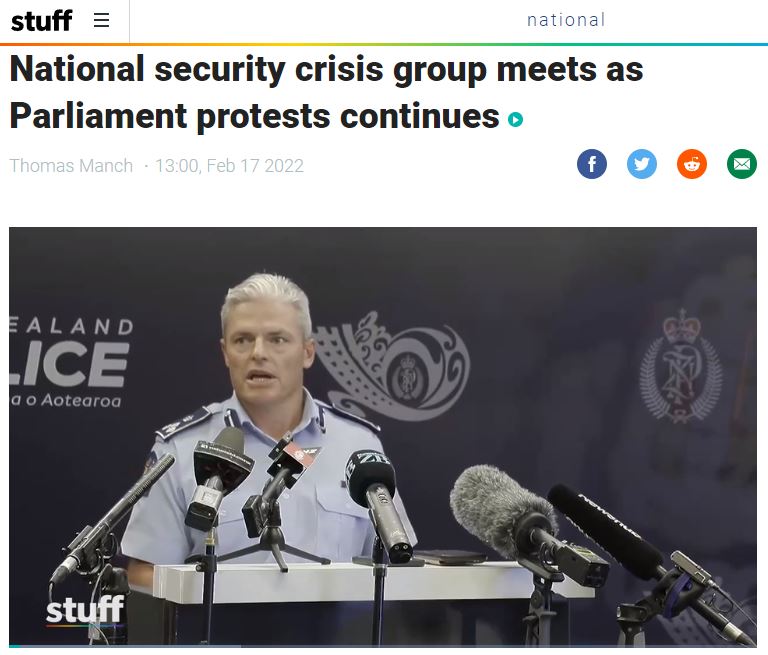
The siege strategy could not have been pursued without the confidence that the Fourth Estate media cartel would act reflexively as the peripheral nervous system to protect the other three estates of the realm, including the First Estate, the Legislature, which is essentially the immune system for the super-rich oligarchy that rules New Zealand.
The news media’s coverage of the termination stage of the police siege on March 2 belies a pattern of NZ’s mainstream newsrooms acting as a cartel. New Zealand’s newsrooms essentially performed the role of media missionaries genuflecting to the state wielding its resources, propaganda and violence to produce bad optics for the Liberty Occupation.
In choosing to side with the other estates of the realm — while demonizing legitimate political dissent — the news media reinforced inter-elite power relations, valorized state aggression over open discussion, maintained a refusal to supply of counter-evidence, reproduced logically flawed arguments to maintain the Corona Cult, and incited hate, promoted prejudice and constructed the criminalization of a diverse convergence of New Zealanders with inherent and inalienable rights to stage an occupation on the Government’s front-lawn.
With such biased posturing, NZ’s newsrooms did not call out Jacinda Ardern for her sleight of hand rhetoric about not getting involved in ‘operational matters’ while supporting the police in their decisions. The convening of the ODESC group, in essence, meant the Prime Minister who doubles as the Minister of National Security and Intelligence, had — tacitly, if not explicitly — got involved in executive level matters to head off a looming crisis for the ruling elites.
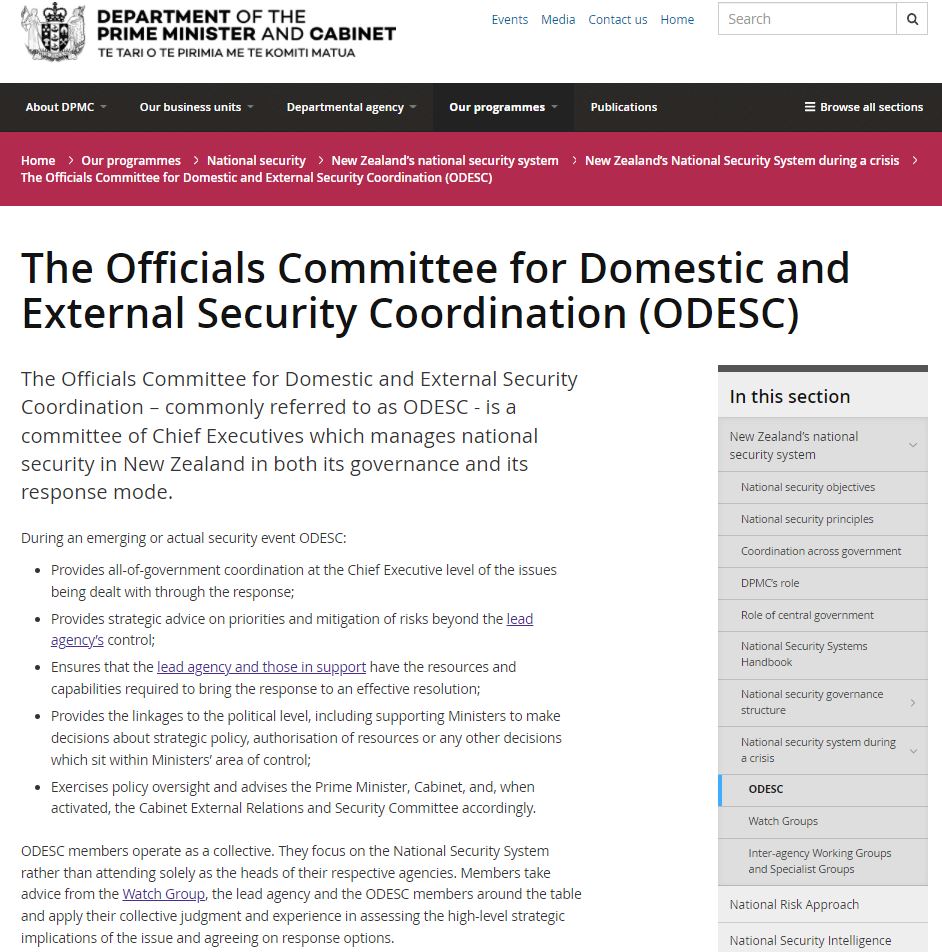
Despite what the media portrayed, the groundswell across New Zealand was significant, level-headed and diverse.
The images of the tents, vehicles and New Zealanders of all walks of life (including many from the working class), freedom camping on the front-lawn of a Westminster-style Parliament — presented bad optics for the government. Such scenes of sustained political dissent had the potential to drive the Ardern Government’s political capital to zero, weaken the National Security State and expose the super-rich oligarchy to a political trajectory they could not control.
Because New Zealand’s newsrooms failed to contest the irony that the institutions that comprise the power structures that ‘govern’ over the people and were also the ones stipulating what was reasonable, lawful and acceptable protest — those institutions were afforded free-reign to run roughshod over the peoples’ capacity to sustain an occupation.
As political scientist E.E. Schattschneider stated in his 1961 book, The Semi-sovereign People, “the definition of alternatives is the supreme instrument of power”.
In essence, NZ’s PM Jacinda Ardern, the Speaker of the House Trevor Mallard and Police Commissioner Andrew Coster et al were saying protest must not only be peaceful, it must also be polite, convenient and of fleeting duration. In short, any protest must evidently be politically palatable and therefore ineffective for it to be politically correct.
In the communications literature on protests, such events that crash the news are one of the few ways open to citizens in the so-called liberal democracies to get their viewpoints noticed by mass news audiences.
Overview – The Criminalization of an Occupation via the News
The photographic, video and eye witness evidence of Thursday 10 February shows that police pursued a strategy to bait protesters, pick-off the weakest links in the human chain and exaggerate the number of arrests to produce propaganda to fracture public support. The protesters were not trying to storm Parliament House.
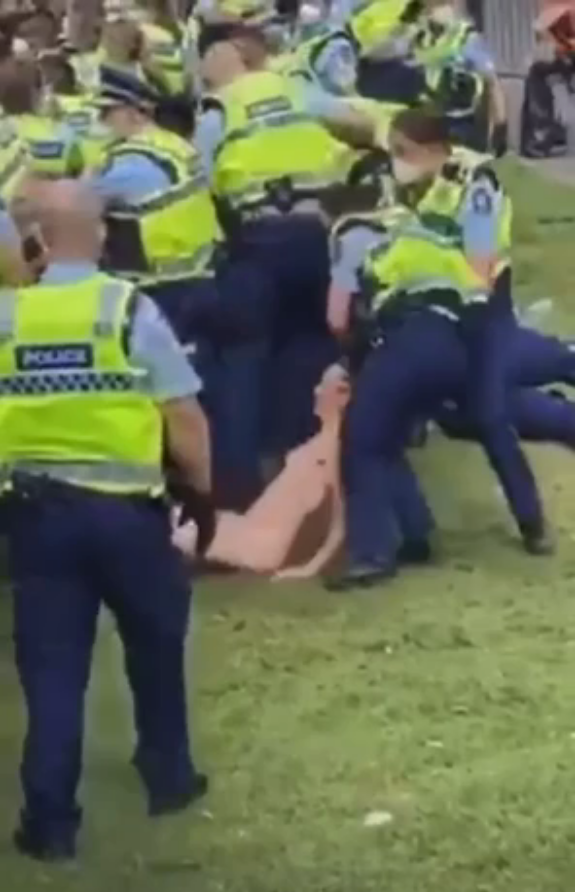
The Police breached the peace on Thursday 10 February to construct a cause célèbre to build-up reinforcements, divide the public and set the stage for a state-sponsored siege of the Parliament Occupation.
After two years of Corona propaganda, the liberty protesters held fast to occupying parliament because the economic warfare wrought by pandemic measures — that were at best disproportionate to the over-hyped threat— have had huge impacts. The liberty protesters also held their ground because the ‘vaccine’ mandates have continued past the original two shots that many were duped into believing would be all that was required. And because the ‘vaccine’ mandate regime has been extended to children as young as five, amid growing concerns about the bioweapon injection’s long-term health impacts, amid commonplace stories of ‘vaccine’ injuries, illnesses and deaths.
Several thousand who came after to reinforce the occupation, or visit to support, cited the police brutality of 10 February as their decisive moment to join the occupation.
In my first Liberty Occupation dispatch, Rhythm and Crimes, I showed how the NZ Police were the primary perpetrators of the aggression, violence and abusiveness, while the protesters were remarkably restrained. The news media played along, claiming the police were attempting to ‘hold a line’, thereby implying the occupation group were trying to storm Parliament.
Following their ‘apparent’ failure to eject the Liberty Occupation from Parliament Grounds (and surrounding streets) on Thursday 10 February, the Constabulary doubled-down.
It is apparent from subsequent events that the Officials Committee for Domestic and External Security Coordination (ODESC) met to end the occupation, rather than arranging to hui with the Freedom Occupiers in front of Parliament House.
A siege strategy had been pursued to encircle the Parliamentary Occupation and encampment of surrounding streets, to limit its supplies, growth and reinforcements, as well as to escalate antagonisms, produce bad optics for the occupiers and ultimately retake Parliament Grounds.
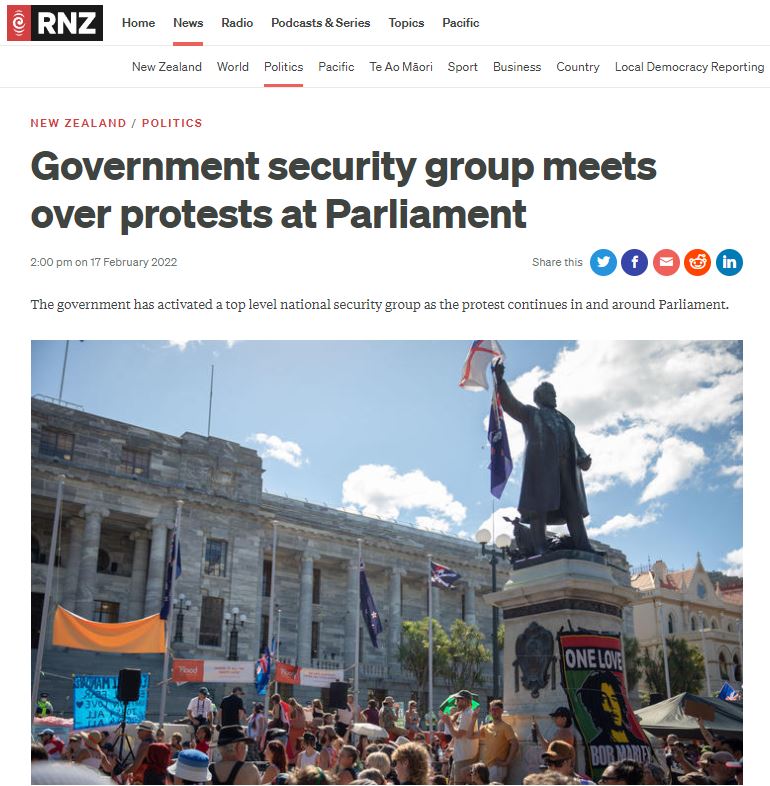
As the syndicated Stuff newspapers reported February 17, in a story headlined — National security crisis group meets as Parliament protests continues — the ODESC group is headed by government chief executives and is the primary committee of the National Security System, which swings into action during crises that threaten (or are perceived to threaten) New Zealand’s security, sovereignty or economy.
It is, therefore, relevant to note that representative democracy, or limited democracy, that is based on the Westminster parliamentary system, was spread around the western world as a strategy to protect the extremely wealthy from the riskiness of “pure” or participatory democracy.
Broadly, the condition for allowing representative or limited democracy is that the democratic society does not bother the super-rich oligarchies, who use their enormous wealth to steer the political trajectory of whole societies — as Jeffrey Winters stated in his seminal 2011 book, Oligarchy.
The images of the tents, vehicles and working class New Zealanders of all walks of life freedom camping on the front-lawn of a Westminster-style Parliament — are bad optics for the government. Such scenes of sustained political dissent had the potential to drive the Ardern Government’s political capital to zero, weaken the National Security State and expose the super-rich oligarchy to a political trajectory they cannot control.
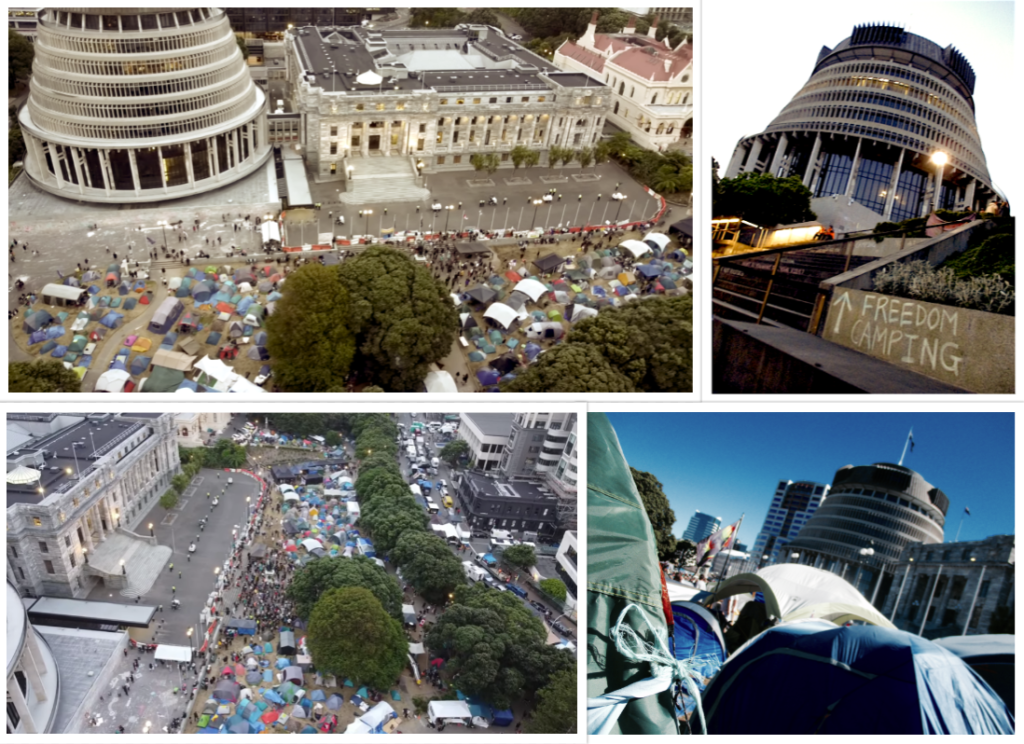
Political capital is the notion that political elites have pubic image credit to spend, which affords them the capacity to pursue unpopular policies, plans or projects. This political capital is vulnerable to attack, if groups can expose the ‘chinks in the armor’ by showing the damage that such policies, plans or projects as they continue to be inflicted upon society.
The police command’s siege strategy of the Freedom Occupation began shortly before 4am Monday 21 February, when a build-up of police was observed by the watcher men and women of ‘Freedom Village’.
With this pre-dawn blockade of eight access and exit points to the Freedom Encampment at Wellington’s Parliament Grounds and surrounding streets with several dozen one-tonne concrete blocks, the police attempted to partially cut-off the supply chain of the occupying force, as well as choke the growth of the occupation.
At its peak, 300 police guarded the trucks and fork-hoists and periodically clashed with protesters, and among them eight were captured for arrest.
The news media reported human faeces were thrown at police during a fraccus at the intersection of Lambton Quay, Bowen Street and Whitmore Street near the Cenotaph. For instance, Newshub‘s headline — Protesters even less likely to get audience with Prime Minister Jacinda Ardern after throwing human waste at police — news anchor framing and Newshub political editor Jenna Lynch’s led viewers to believe their authoritative posture.
Mike McRoberts claimed the parliament protest hit a new low when he introduced the story about the police allegations of human faeces supposedly thrown at police by a protester. Samantha Hayes said the incident happened while police were laying barricades. With these statements, the two news anchors supported the unproven allegations made by police and led Newshub‘s audience to believe the claim was actually true. Jenna Lynch claimed human faeces were “hurled at the cops” by “the mob”, “the guys”, and “the protesters” — but supplied no evidence to back this position.
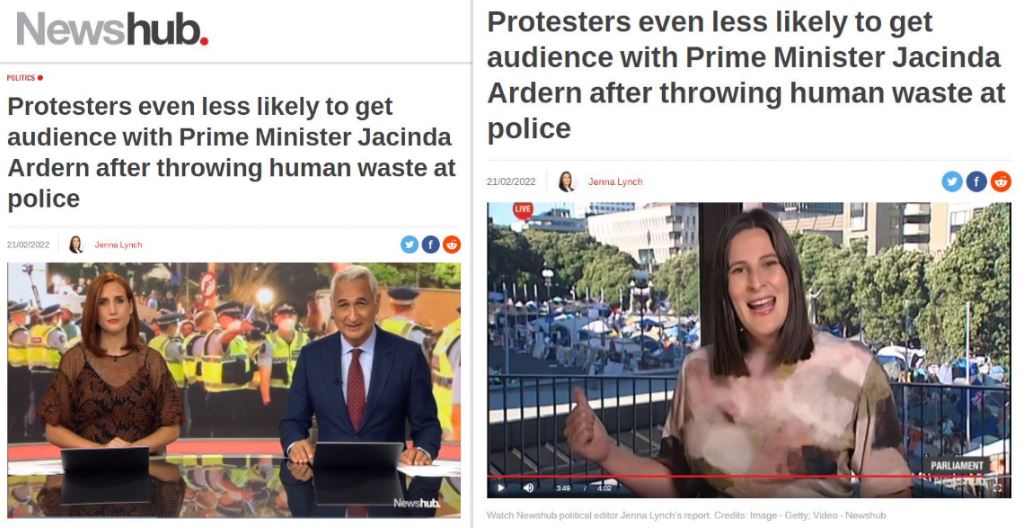
Indeed, the Police provided no evidence to back their accusation, despite being a law enforcement institution that is supposed to ground its investigations in facts, rather than conspiracy theories.
Then on Tuesday 22 Feb, the sudden addition of the riot shields to the police command’s siege strategy of the Freedom Occupation was, in fact, a narrative seeding that riot police were needed.
Twenty-five police brandishing riots shields ran at a group of anti-mandate protesters next to the Parliament Grounds in Wellington at 13 minutes to seven in the morning.
The riot-shield wielding police had been standing by, at the back end of the Archives New Zealand building on Molesworth Street [marked with red ring], while the Police frontline stood by the newly laid bollards to cordon off a section of the street.
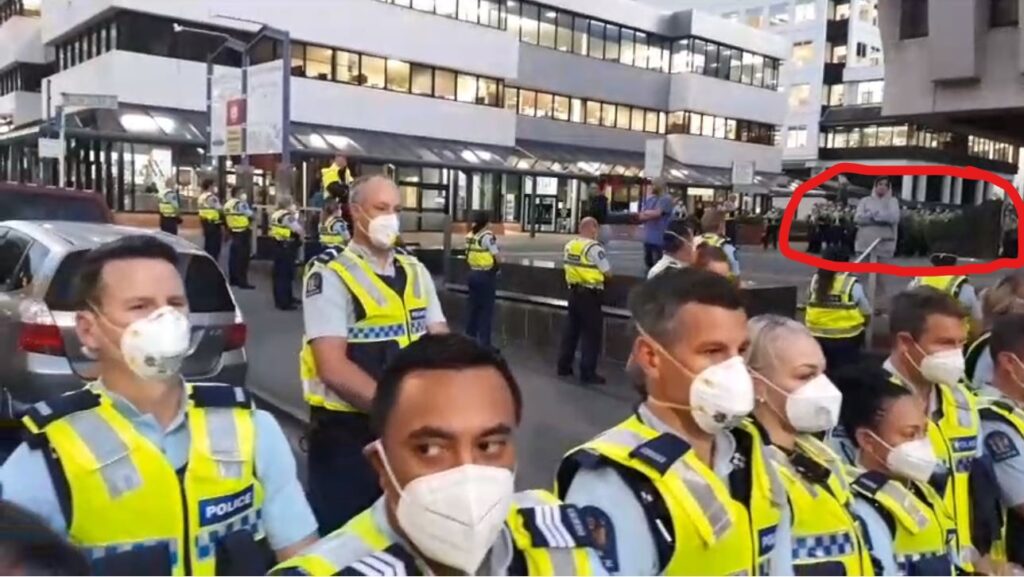
The sudden deployment of riot-shield wielding police who run toward protesters — while they were milling around by the port-a-loos — was intended to construct bad optics for the Liberty Protest Group.
In the morning light, at 6:45am, the purpose was to bait protesters to produce shoot-able images of violence for the breakfast news. A more aggressive team of police surged forward, squeezing protesters against the port-o-loos and nearby vehicles.
The Wellington police command claimed the protesters squirted battery acid at police. Subsequently, a video has gone viral that shows a police officer spraying a pepper aerosol aimed at unknown persons offscreen and a few seconds later a police officer walks into frame clearly disoriented, indicating he can’t see properly.
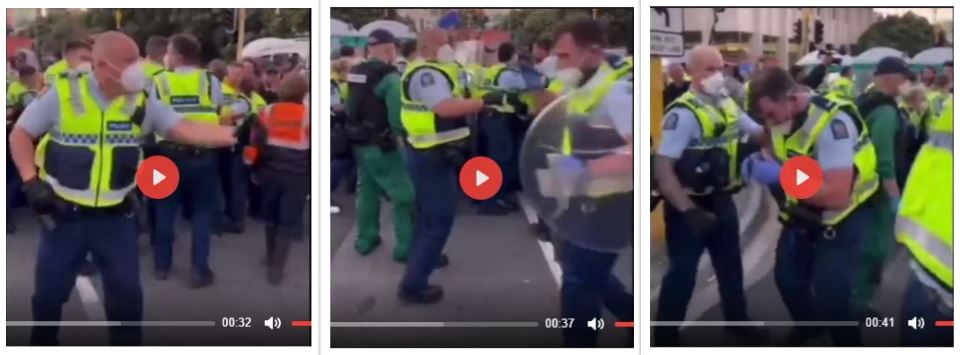
Newstalk ZB show host couple Heather du Plessis-Allan and Barry Soper expressed skepticism about the police claims following the emergence of the video. Heather du Plessis-Allan suggested it was prudent to question all the claims made by police, regarding the faeces, battery acid and allegations of sexual assaults, and had come to realize a smear campaign meted out by police (or the SIS) was more likely.
This was a remarkable turn-a-round given that the previous day, du Plessis-Allan had bought the police line, stating her opinion in a segment headlined, “The protesters are losing the PR battle”.
In an interview with protest liaison Leighton Baker, he said he was told by some protesters that a man in a black balaclava evidently had a container with suspect fluid that he threw at the feet of police. Baker said there is no one at the protest who walks around in balaclava, or any masks, and the legitimate protesters on the frontline were reminding the small percentage of people who were antagonistic of the need for love and peace.
In a similar way to the police instigated violence of Thursday 10 February, the occupiers were not trying to provoke the Constabulary. It was the police who breached the peace, to bait protesters who were shoved backward against the port-o-loos, the nearby vehicles, and one another.
The escalation of the siege strategy to its termination stage on Wednesday March 2 meant that the police, once again, were the instigators of violence.
As I described in my sixth Wellington dispatch, Police Escalate Siege of Parliament Occupation at Dawn, at approximately 8:30am, police with riot shields pushed forward against a line of protesters at the top of Molesworth Street. As with previous close encounters between police and protesters, such police pushes are designed to stretch linked arms to that police can more easily pick off humans for arrests, beatings and treatment as caged animals.
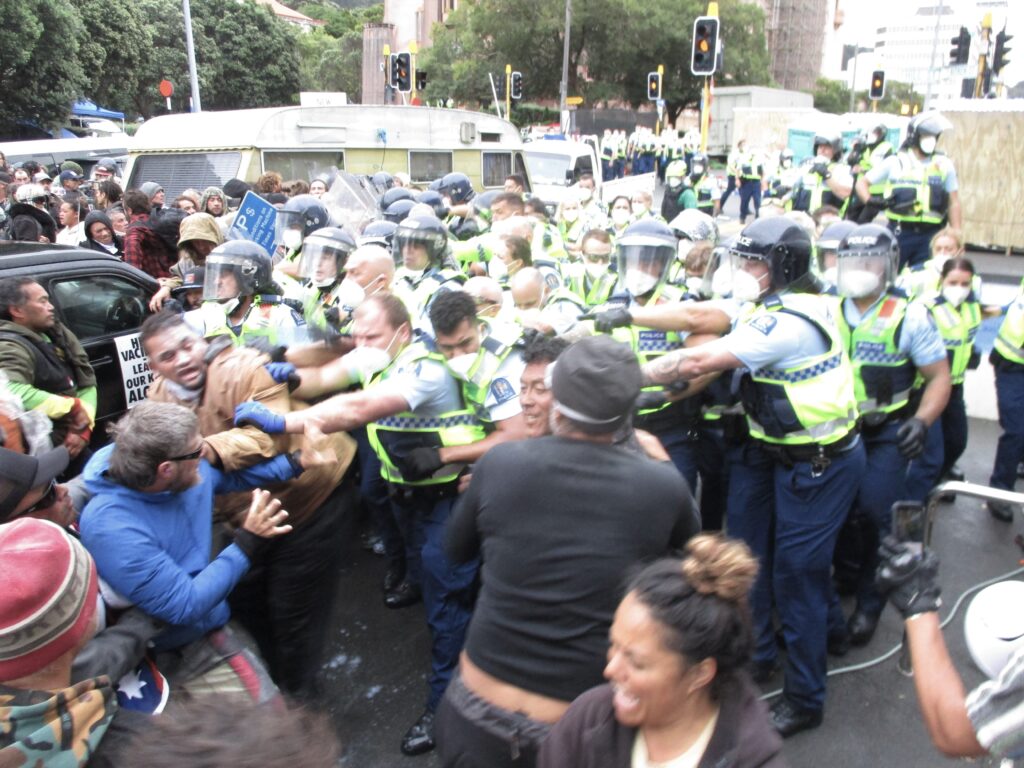
When police moved through gazebos across the other side of Molesworth Street by the northern boundary of Parliament Grounds, this action further antagonized protesters. Some of the less disciplined protesters or idiots who merged with the protesters retaliated by throwing objects, flicking paint, or yelling abuse at police.
Numerous protesters were pepper sprayed while several arrests were made.
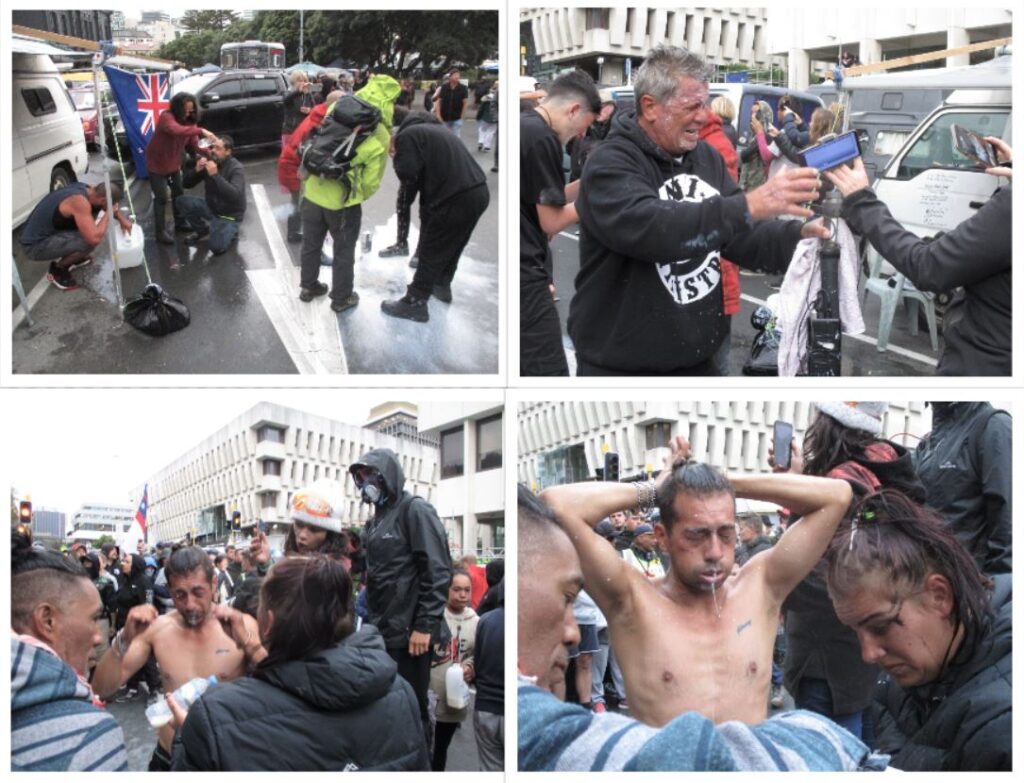
At approximately 2:40pm, fifty paramilitary police from the Special Tactics Groups and the Armed Offenders Squads ran down the stairs and path from the Parliament Legislative Library on to the pavement by the northeastern Parliament Gates adjoining Molesworth Street, where the Freedom Village Security Tent was located.
Police pepper sprayed, beat and arrested occupiers who were attempting to hold the line to protect the tents, gazebos and educational displays from being ripped out.
Once this line was broken through, police in riot gear advanced the police line across the lawn ripping out tents, while pepper spraying occupiers.
The news media stated the fires were started by protesters, rather than what appeared to be a gang of mostly men who also relished throwing projectiles at police. The news media also dismissed out-of-hand the possibility that the police had planted violent infiltrators with protester covers, in order to justify the use of physical force.
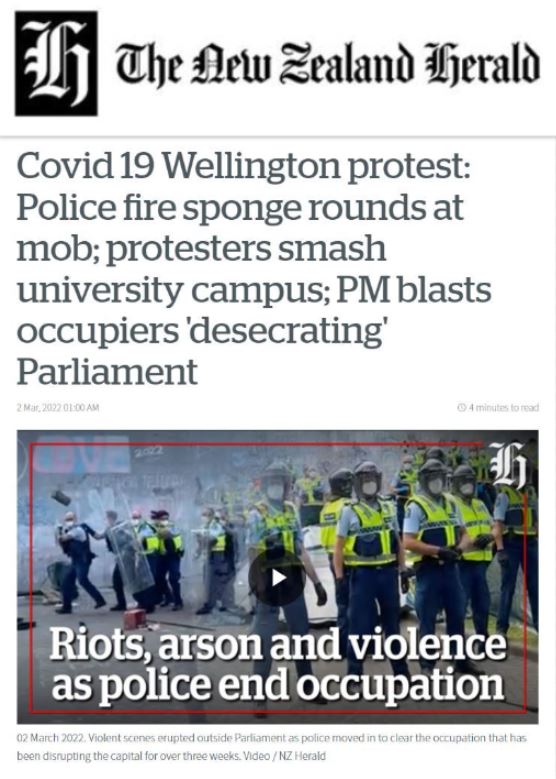
The intention underpinning the National Security State’s siege strategy was intended to diminish numbers, undermine public support and focus on law and order issues with the objective to deflect attention from the avoidance of the sitting government to parlay with the Occupation Group.
A staged provocation to justify the full use of the paramilitary police squads, the Special Tactics Groups and the Armed Offenders Squads AOS, would be consistent with the totalitarian machinations that have occurred in Australia, Canada, England, France and Germany — among other nations of the Western Alliance.
If the Ardern Administration were to buckle to the demands of the NZ Freedom Movement to end the Covid Mandates, the biosecurity system that has been implemented under the rubric of the engineered Great Corona Reset mandate would actually collapse.
Since this siege strategy was a provocative move to forestall the Ardern Government having to parlay with the Covid-19 mandate resistors, it is incumbent on the media to report events accurately, with balance and fairness and without discrimination.
Especially, since the Police command, the Executive Branch of Government and the Wellington Political Elite were exploiting their strength as official sources. In accordance with inter-elite power relations, the Establishment Media treat official sources with the idea of presumptive accuracy, especially in times of crisis, as Noam Chomsky’s Propaganda Model predicts.
Meanwhile, New Zealand’s media missionaries adopted a posture of neutral bystanders. Gallingly, they did not take any responsibility for their incessant role of reproducing fear-porn corona news on behalf of a global elite, who have been gas-lighting the world for the past two years.
As I described in my first heretical Letter to the Future from the Time of ‘The Crazy’, entitled — “How the World is going to Hell in a Corona Hand-Basket” — most people do not recognize we are in the early stage of World War III, in which all of humanity — except the totalitarian global elite — have been cast as covid suspects. This epic global war seeks to destroy household autonomy, wreck free enterprise and construct a totalitarian universal empire through domination of the Chip Revolution.

Therefore, I find the mainstream media newsrooms have been complicit in the breaches of the peace by police.
Because New Zealand’s mainstream newsrooms have repeatedly and deliberately produced inaccurate, unbalanced and unfair coverage of police breaching the peace, inciting violence and inflicting brutal attacks to destabilize the Freedom Occupation, the news media have left themselves wide open to being prosecuted for breaches of section 240 of the Crimes Act, which deals with crimes of deceit.
Thursday 10 February 2022: Nine-Hour Attempted Police Siege Parliament
Prominent brands of New Zealand’s media cartel, such as The New Zealand Herald, The Dominion Post, 1News, Newshub, NewsTalkZB, The Otago Daily Times and Radio NZ failed to accurately describe the cluster of events at Parliament Grounds on February 10.
The tight framing of the images, together with headlines repositioning the occupation as a law and order issue, and the ironic colonization of the phrase “hold the line” meant that readers were lead to believe the protesters were attempting to storm Parliament House.
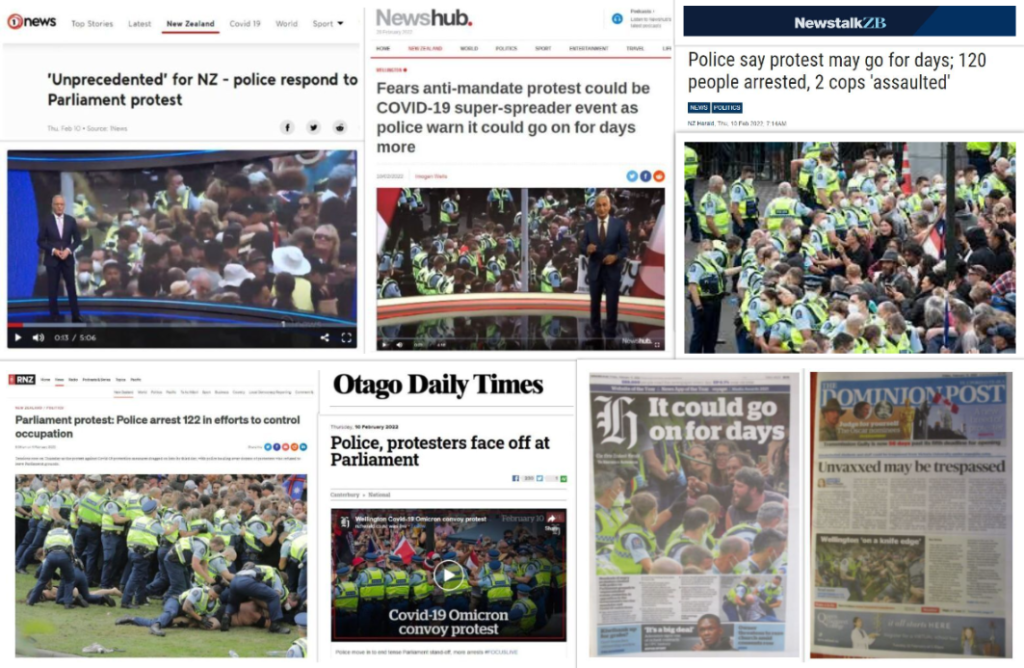
In their report headlined “Parliament protest: Police arrest 122 in efforts to control occupation”, Radio NZ claimed the police made arrests as “they continued to hold the line”. RNZ did not bother to describe the obvious police driven aggression because the news outlet had picked the same side of the political fight as its funder: the Crown.
Similarly, The Otago Daily Times opened its story headlined, “Police, protesters face off at Parliament” claiming:
“Police have made more arrests this afternoon as they continue to hold the line against anti vaccine mandate protesters who have refused to leave the grounds of Parliament in Wellington.”
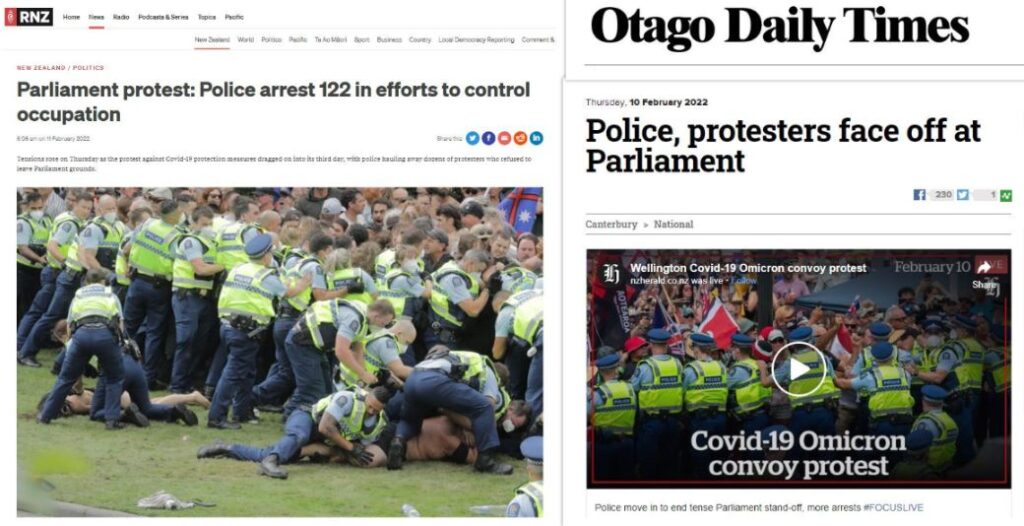
Newshub‘s Imogen Wells inferred the violence came from the protesters, rather than the police. With polished bias, fecklessness toward accuracy and flippancy about fairness, Welles performed the neat trick of feigning ‘balance’ by supplying a couple of soundbites from protesters to counter the police blaming the protesters for the aggressive friction.
Nor did Wells explain the position of the frontline that the police had formed despite the use of this wide-shot which was used two thirds of the way in the story while her narration introduced a local beauty salon owner claiming his clients were too scared to come into the CBD.
Because the shot was not explained as the position of the frontline, viewers could have been left with the impression that the police had also surrounded the protesters across the entire forecourt to prevent them running up the steps to Parliament House.
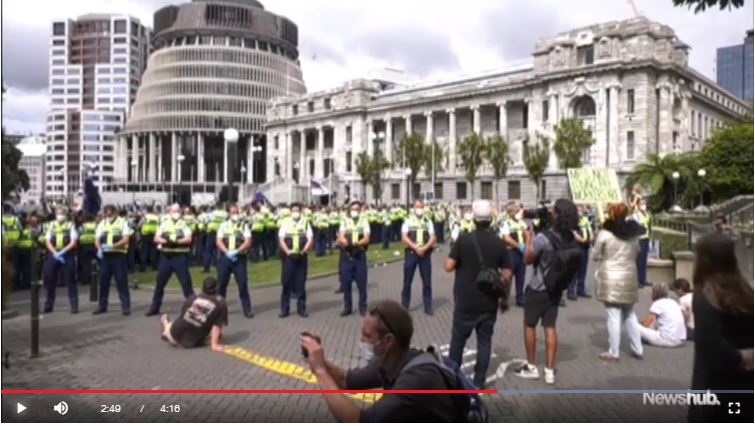
According to Wells, the “authorities [were] in for another night of chaos”, as she claimed with her concluding clichéd line.
Ironically, Wells did not reconcile the contradiction of why the occupation had become peaceful once the bulk of the police withdrew at the end of their shift and following Supt Cornell’s smugly chummy presser the accredited media at the rear end of the Beehive deep behind state police lines.
Remarkably, Wells asserted that the day’s extraordinary action felt like the peak of the protest action, adding there were still a significant number of protesters at Parliament Grounds.

The motives, means and modus operandi under-pinning the police brutality of 10.2.2022 at Parliament Grounds have been spun to cast blame on the pro-liberty/anti-mandate occupation protesters.
However, New Zealand’s government, police and media have yet to explain the facts on the ground truthfully.
The NZ Police, Government, and Establishment Media have alleged the protesters became aggressive, violent and abusive, while Police were attempting to ‘hold a line’, thereby implying the occupation were attempting to storm Parliament.
However, the photographic, video and eye witness evidence shows that police pursued a strategy to bait protesters, pick-off the weakest links in the human chain and exaggerate the number of arrests to produce propaganda to fracture public support.
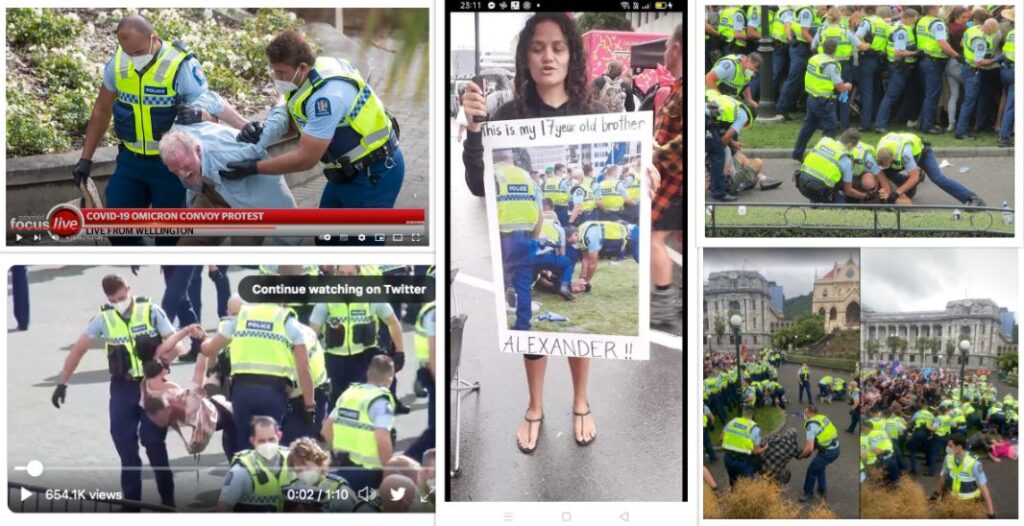
Police acted on a letter composed by Trevor Mallard — who as a creature known as the Speaker of the House — has powers over Parliament and especially precious ones while the debating chamber is not in session. Mallard claimed the Freedom Camp occupiers breached rules which amounted to trespassing.
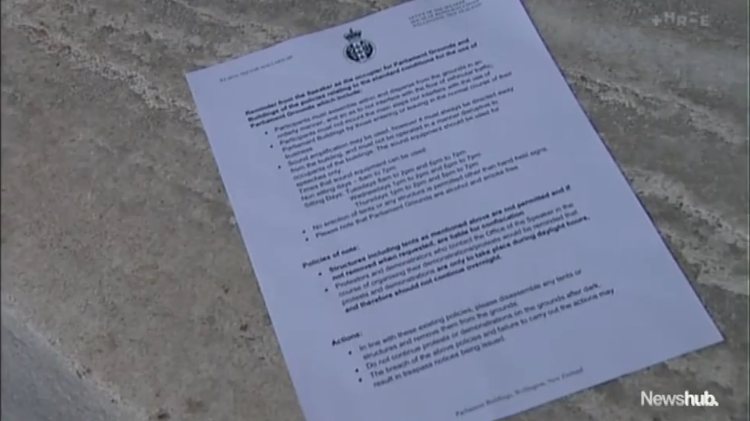
Mallard justified the arrests because it was claimed school children were intimidated for wearing masks, and local businesses were harassed. No evidence, affidavits or attempts to police the streets to mitigate such alleged encounters, appeared to have occurred. In fact, the lack of a police presence during the first two days of the occupation seems to a belie a strategic withdrawal of security.
Wellington Superintendent Corrie Parnell claimed 120 arrests were made. He also asserted that the police actions were a measured proportionate and fair response to alleged offences of trespass and obstruction.

Anti-mandate protesters claimed that police used brutal and unprovoked force to achieve the arrests, which numbered between 30 and 50 pro-freedom humans.
The logic underpinning the escalation in police numbers was to inflict an aggressive series of tactics to get a high number of arrests, which would both serve as propaganda to attempt to marginalize the Parliament Occupation and also as a poorly judged attempt to intimidate the occupiers to give up. The operation appeared to be designed to cause the occupation to collapse, and forestall any more travellers joining amid an intended defeat inflicted by the state’s constabulary.
Numerous eye witnesses noted there are several facts on the ground that undermine the narrative that police acted in a measured, proportionate and fair manner for the alleged offences of trespass and obstruction.
Shortly after 8am Thursday 10 February, when Police formed a line along the pavement at the north-eastern end of Parliament grounds. Some protesters remained standing, while others sat down, locked arms, which is a tactic to deter police from arrests – since a sitting person projects an image of peace.
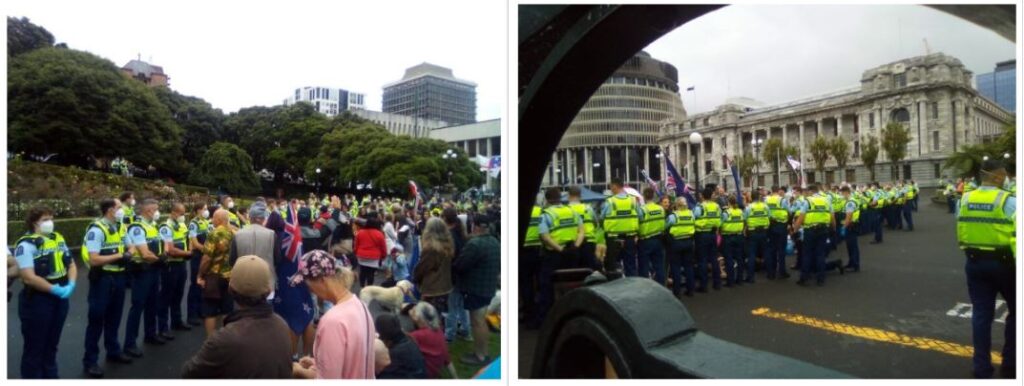
Soon after, the police commenced making arrests, while some of the occupation group were sitting down on the pavement and grass with arms linked. The arrested were lead away to the northern end of the stone Parliament House.
The police surged forward more aggressively, at which point the protesters gave up on sitting because they were copping knees, boots and falling bodies as police forced their way deeper in the ‘frontline’.

Several arrests were made by sub-teams that picked off protesters from the ‘frontline’, while the other Police pushed forward.
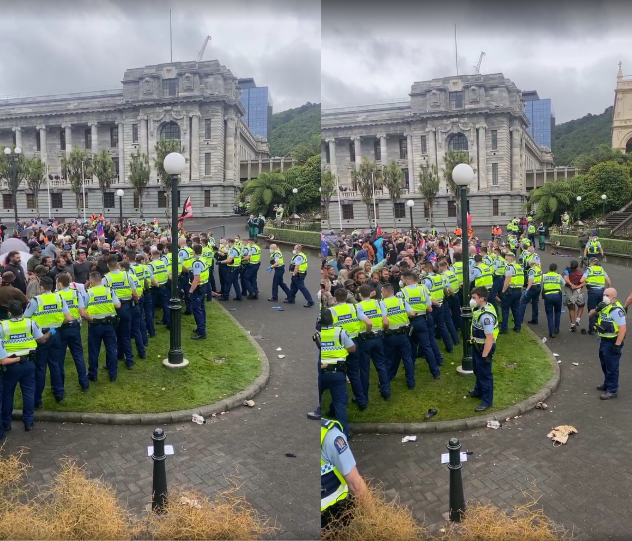
The police chose to pick off mostly easy targets such as old people, teenagers, women and the overweight, who were deemed to be weak links in the human-chain.
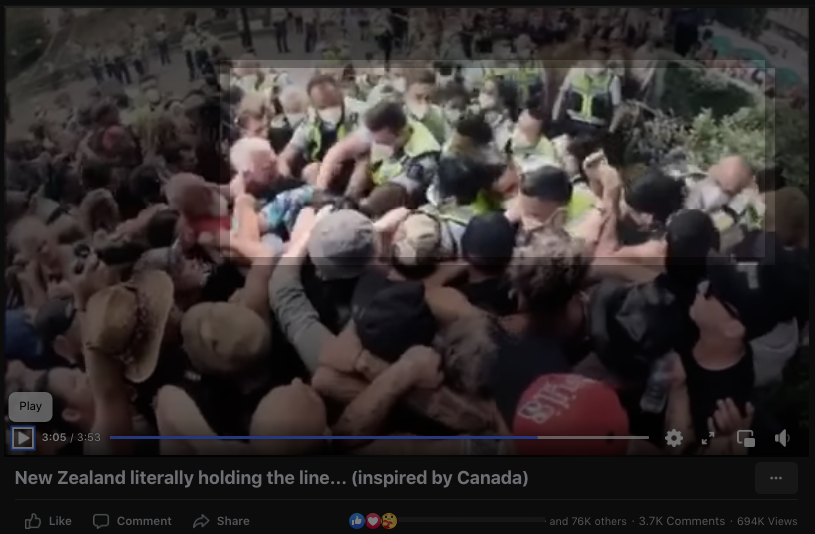
The New Zealand Herald reported that Supt Parnell stated that the charges made were for trespass and obstruction.
Curiously, neither Supt Parnell, nor the news media stated that any protesters were arrested for assault. This apparent anomaly occurred despite Supt Parnell claiming two of his officers were assaulted and pepper spray was used because Police were dragged into the crowd.
The statement that Police officers were dragged into the crowd and justified the use of pepper spray was misleading.
Supt Parnell — who began his presser with the salutation, “Afternoon Team”, like the assembled accredited media were his chums — neglected to mention that his officers attempted to steal tents. His police team’s attempted theft was part of a diversion tactic down by the steps in near the Richard Seddon statue.
A few police had ventured on to the lawn of their own accord, and more were stopped by the freedom occupiers. The Constabulary were surrounded by occupiers defending their property on land that their taxes pay for the upkeep.
The footage of police shoving, pushing and grabbing protesters targeted for capture in surges at the ‘frontline’ — were the result of predatory police-instigated aggression, rather than originating from the occupation group.
The ‘frontline’ protesters were defending was the grassy ground, because behind them were 100 tents pitched across a sprawling lawn.
The misleading front-page headlines, images, and opening paragraphs of The New Zealand Herald and The Dominion Post were framed to make the situation seem like the NZ Freedom Convoy 2022 occupation group were attempting to storm the front-doors of Parliament House or the Beehive.
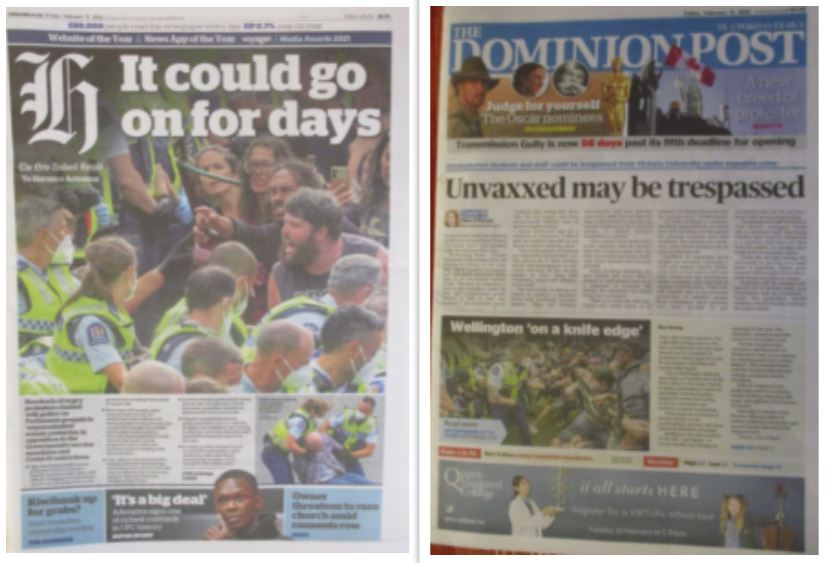
For instance, The New Zealand Herald front-page stated:
“Ugly skirmishes broke out as protesters tried to breach a heavily manned police line, with officers dragging out individuals one by one, pinning them to the ground then leading them away in handcuffs.”
The Herald claimed that police were holding off protesters as they tried to “break through the cordon”.
A mid-wide photograph on pages 4 and 5 of the Herald shows the cordon at the edge of a footpath. But the location of this footpath is unclear to most readers, especially if they are unfamiliar with the grounds. A wrought iron gate in the background is really the only indication that the frontline was located toward at the northern end of the grounds.
Meanwhile, The Dominion Post claimed:
“The protest began relatively peacefully on Tuesday but, as the days rolled on, the anger started to swell, culminating in waves of protesters running at police, spitting at media and hurling abuse at commuters and workers in nearby businesses.”
Neither major newspaper, nor 1News or Newshub described the aggressive police behaviours, including the grievous bodily assaults of protestors in the form of shoving, wrestling, yanking, pressing, punching, kicking and dragging on the ground.
Radio NZ and the other news outlets who recorded Supt Parnell’s press conference did not question the legitimacy of the police or the legislature — as two estates of the realm — working in cahoots to interfere with the capacity of citizens to sustain a protest by occupying Parliament Grounds.
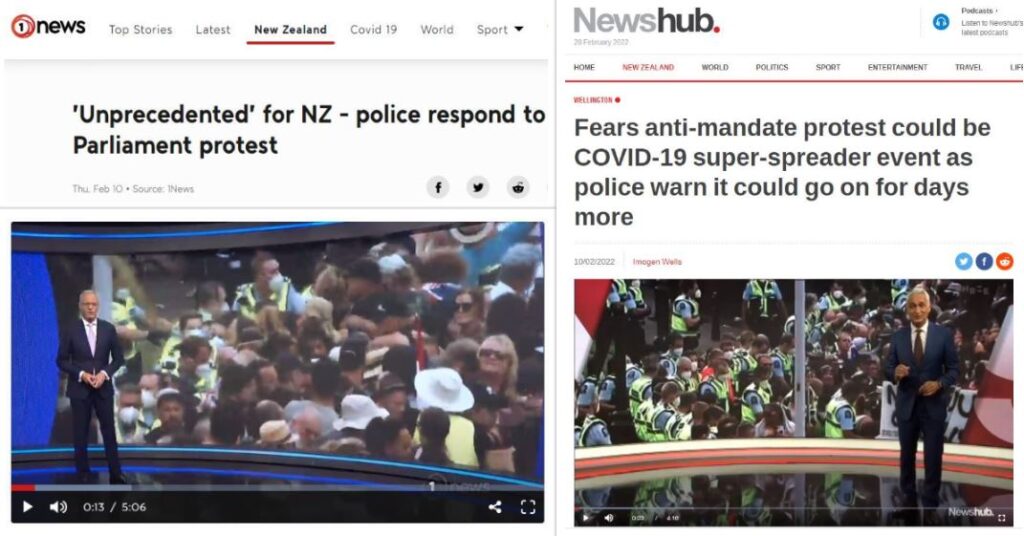
Instead, any counter-views were left to protesters and therefore the news media adopted a neutral bystander posture. The news media could have called out the police for acting as a criminal group by inflicting the violence — since the mayhem unfolded clearly in front of their eyes or in the footage, while protesters attempted to block their advance on the tents.
After the initial burst of arrests of the morning, there was a de-escalation in the tensions while the Police processed their victims. By lunchtime, the number of people gather in the grounds had swelled to approximately 2000 people. Many who were sympathetic to the anti-mandate/pro-liberty cause came from work or from the suburbs of Wellington to offer support, move in and check out what had occurred.
This period of calm relative to the prior and subsequent violence emanating from the predatory police sub-groups had remained unexplained by New Zealand’s media missionaries, the NZ Police and the NZ Government.
From the vantage point above the sloped rose gardens leading to the Parliamentary Library at the northern end of the Parliament Grounds, I could see that a Policeman who thought that the shoving originated with protesters, was completely wrong.

Tensions escalated in the early afternoon at around 1:15pm, when approximately 20 predatory police strode from the northern end of the Parliament House along the paved forecourt area. This sub-group attempted to slip through the cordon fence and on to the lawn a short distance from the statue of Premier Richard John Seddon (1893-1906).
A few sharp protesters read this police diversionary tactic and rushed to the cordon, preventing most from breaching Parliamentary Security Services cordon, as the NZ Herald Focus Live footage shows from approximately 5 hours, 14 minutes and 15 seconds (Wellington Covid-19 convoy protest, 5:14:15).

Police tried to upend a red gazebo to distract the occupiers while the Police moved to arrest people at the frontline, after they failed to breach the security cordon to enter the lawn area to steal tents. One officer pepper sprayed several protestors below him, while a constable’s pepper spraying went awry when the wind blew the stinging aerosol in his eyes.

This 6.2ft officer — who pepper sprayed himself — was fretting, sobbing, and wriggling according to injured-and-uninjured-eyewitnesses — including one builder who stopped more police slipping through by shoving the security fence against the concrete wall next to the steps.
Once this diversionary tactic was set in motion, many protesters were drawn away from behind the ‘frontline’ — as intended.
Meanwhile, two sub-teams were standing by behind the main police frontline and readied themselves to make their assaults on their targets.
Next, the Police formation along the ‘frontline’ surged forward pushing their weight into one another’s lower back, to shove the protesters backward.
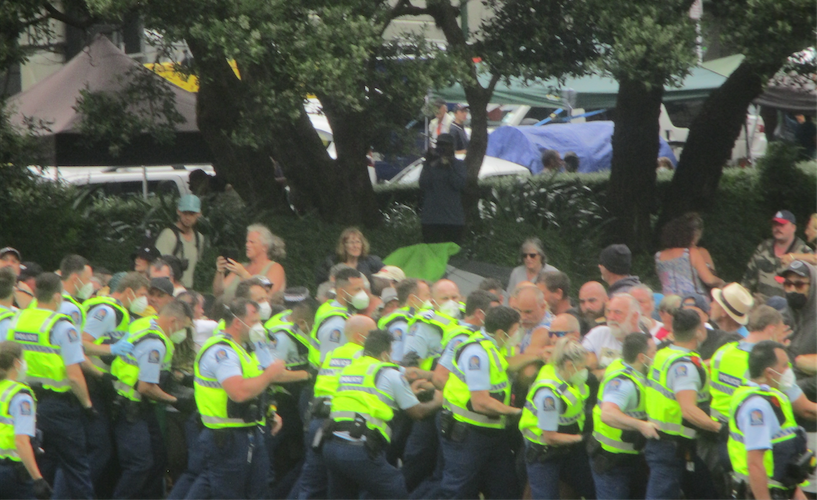
Amid this great shove, the two sub-teams of Police assigned to the more aggressive task of breaching the ‘frontline’ pushed forward to pick off as many easy targets as they could.
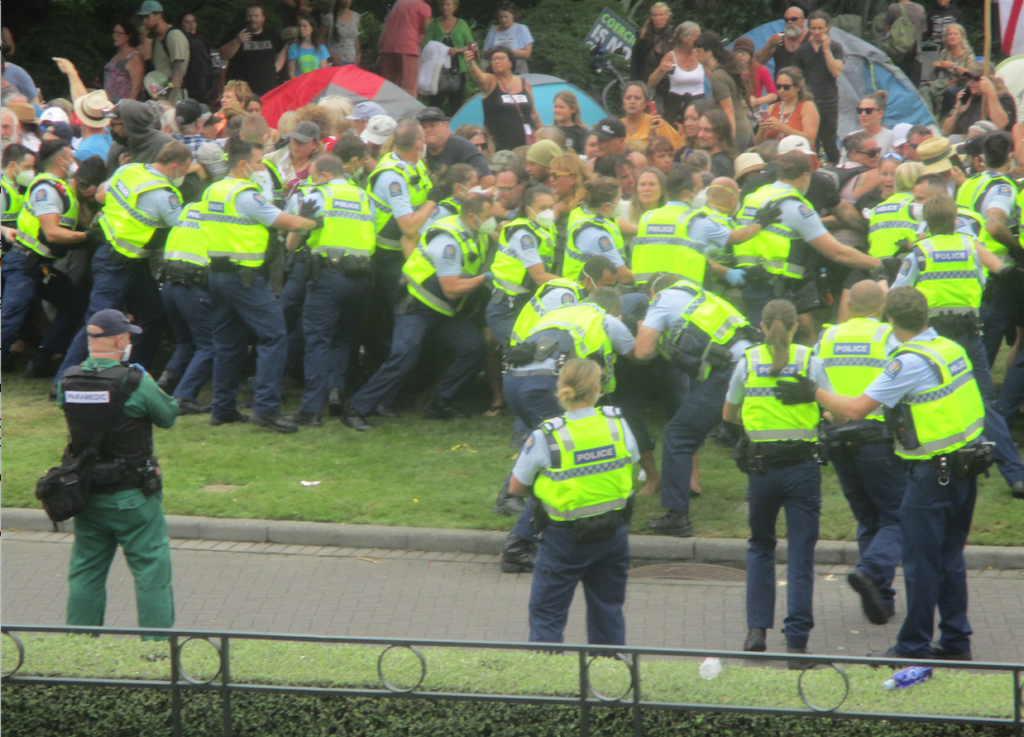
After several formerly free range humans were led, carried or dragged off to the north eastern corner of Parliament House — near where the diversion group had assembled — a long and uneasy lull in the Liberty Battle at Parliament Grounds commenced.
During this lull, I spoke to a middle-aged woman who told me she had left the police force 10 years prior. She was disgusted with the Police’s predatory tactics, brutality, and subversion of a peaceful occupation.
Below us, I could see the Police ‘body snatchers’ readied for another assault, since there were now three sub-teams lined up perpendicular to the Police on the ‘frontline’.
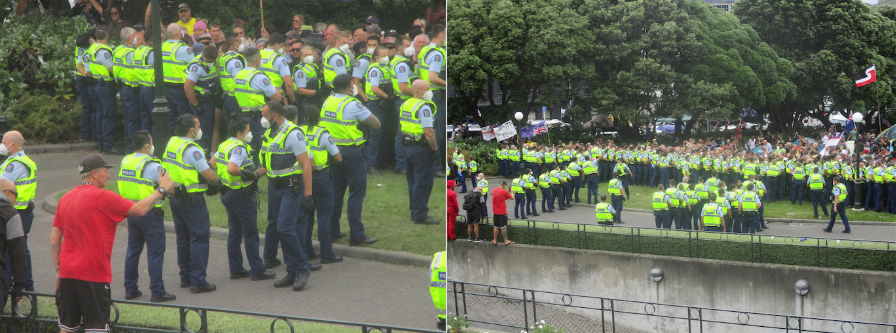
A retired gentlemen — who was encamped at Victoria University’s law faculty campus with his wife — filmed me giving me an explanation of the police tactics, including how the previous assault started with the diversionary manœuvre. I described how the Police had earlier surged forward like a rugby scrum, and the sub-teams had moved in to snatch, pull and drag protesters out for arrest.
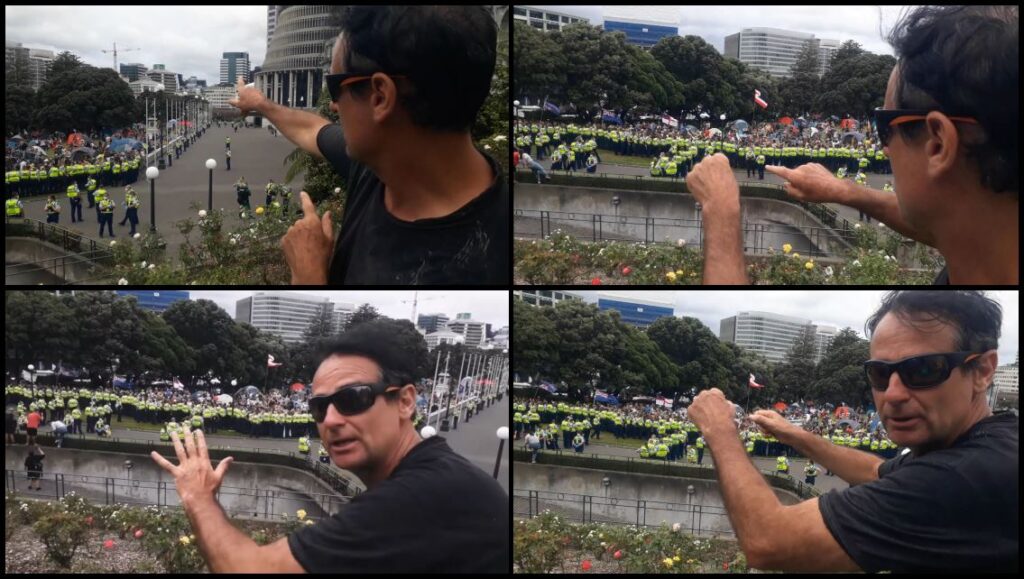
Before the videographer stopped recording my explanation, he remarked, “So, things aren’t looking good for the protesters”, to which I affirmed his assessment. He asked me who I was and I replied “Steve Edwards, Snoopman News”, like you might while filing a story on a news network.
Then we saw the diversionary manœuvre commencing below me.
This occurred at approximately 2:15pm, New Zealand time.
When he pressed record again, I gave a commentary of the unfolding diversionary manœuvre — which as I predicted — drew protestors supporting the ‘frontline’ to the far end of the Parliament Grounds.
During the unfolding mayhem, the gentlemen panned away from me pointing out the diversionary manœuvre, to the Police brutality in the distance.
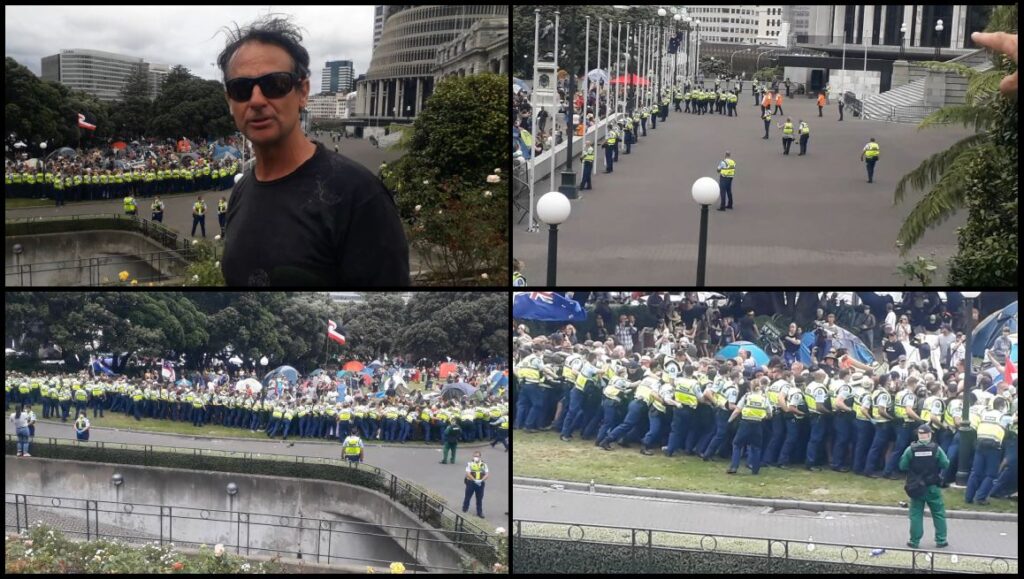
As I had just explained the ‘frontline’ Police surge forward in unison and the three sub-groups moved in to pick off more victims.
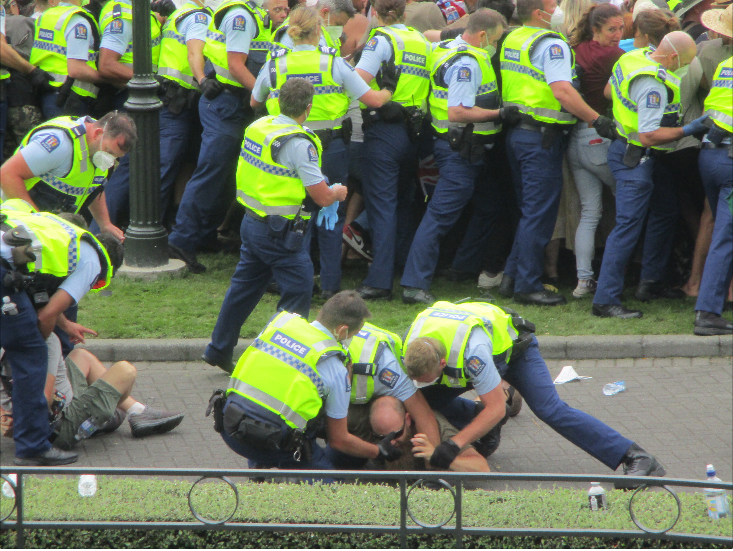
Later in the afternoon, approximately 5pm, the Police voluntarily fell back from the frontline and the crowd walked them backward to much cheering. The builder and his girlfriend — with the heart made of an undefined ethereal substance — were watching while holding their picnic chairs.
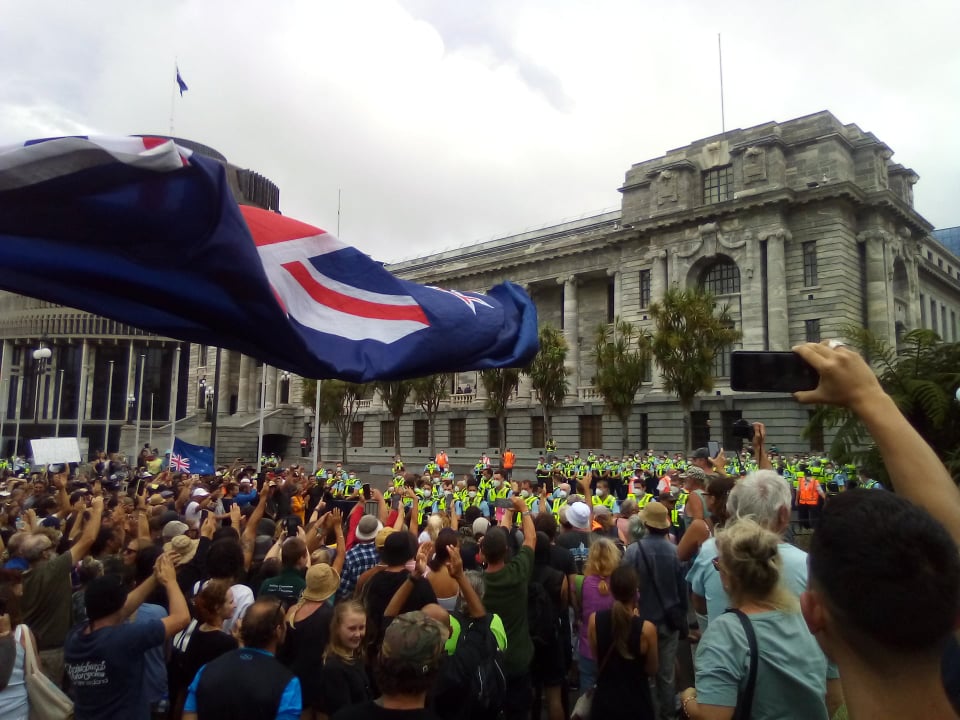
It would appear the Police commanders believed they could scare off the remaining protestors, if they went hard and early, and that with a high number of arrests, they could deter more people from joining.
The restraint exercised by the occupation group was amazing to witness, despite the incessant provocation amid the politicized predatory police operation.
If the police aggression of Thursday 10 February at Parliament Grounds was the strategic error many thought it to be, then the subsequent siege of the Freedom Encampment indicated the police — had formulated a siege strategy to retake control of Parliament Grounds and the surrounding streets.
However, this siege strategy inflicted by the Police in conspiracy with the Officials Committee for Domestic and External Security Coordination (ODESC) operating out of the Department of the Prime Minister and Cabinet — could not occur without the confidence that the Fourth Estate media cartel would reflexively protect the other three estates of the realm.
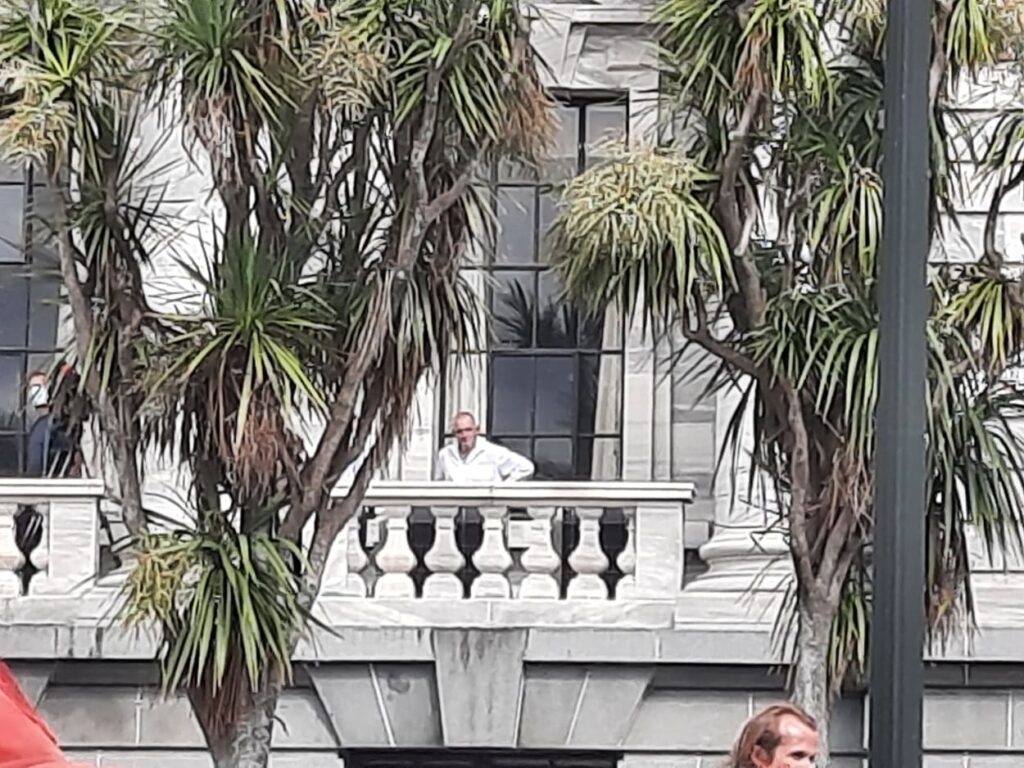
Indeed, none of these news outlets bothered to call out the New Zealand Police for their brazen decision to breach the peace, beat up protesting humans and unlawfully arrest the occupiers — in politically-charged attempt to scare off the remaining occupiers.
In a press statement, Superintendent Corrie Parnell, Wellington District Commander claimed:
“We continue to acknowledge people’s rights to protest, however those who behave unlawfully will face arrest.”
Ironically, this statement — which in the public relations industry is known as an inoculation tactic — was repeated by RNZ and the Otago Daily Times. Inoculation tactics are deployed where the weakness of the matter at hand is acknowledged, then quickly brushed aside. The intention is that the news audience will think no more of it, satisfied that there is nothing under-handed to see, as the documentary The Hollow Men showed.
Monday 21 February 2022: Pre-Dawn Blockades
Prominent brands of New Zealand’s media cartel, such as The New Zealand Herald, The Dominion Post, 1News, Newshub, NewsTalkZB, and Radio NZ failed to accurately describe the police siege of streets, Monday 21 February 2022.

In their news report, PM gives protesters stern message after human waste thrown at cops, 1News conveyed Ardern’s sanctimonious rhetoric claiming that police were merely trying to bring law and order to Wellington, when protesters she alleged threw human waste at officers.
As such, 1News failed to challenge Ardern on her manipulative rhetoric, since Police were being used for stifle political dissent that openly challenged the Ardern Government’s Covid policies, New Zealand’s emergent human biosecurity system and her administration’s judgment to manage a nation.
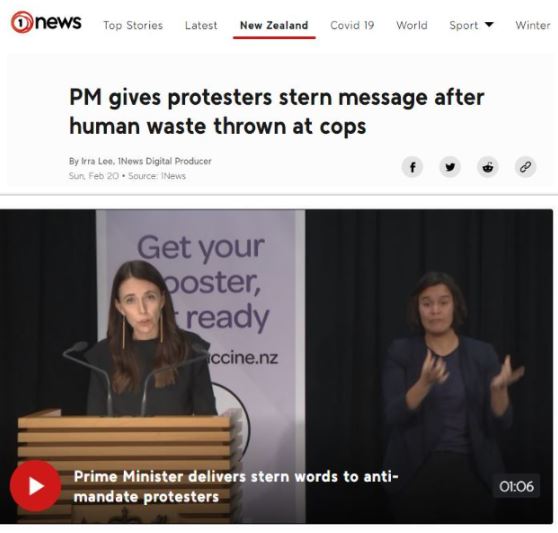
As I pointed out above, Newshub‘s story — Protesters even less likely to get audience with Prime Minister Jacinda Ardern after throwing human waste at police — framed the alleged human faeces-throwing incident as true despite the police supplying no evidence to back this position.
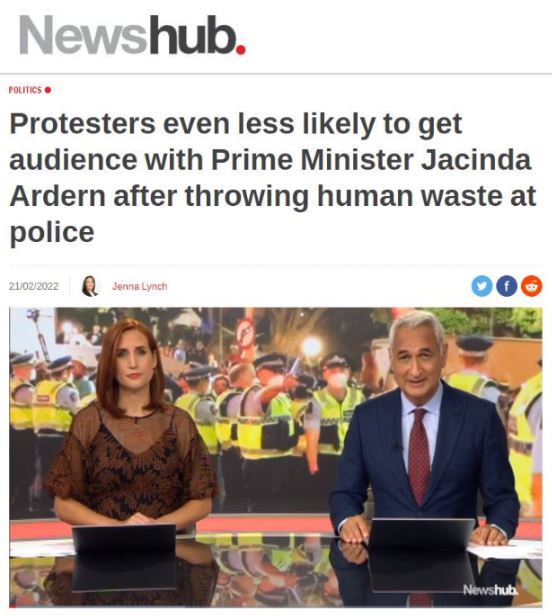
In “Clashes between protesters, police as fireworks let off; PM reveals when mandates could ease”, NewstalkZB repeated the human waste throwing accusation. NewstalkZB reported a police statement which evidently read:
“Deliberately infecting someone with disease is a serious offence punishable by 14 years imprisonment. Likewise attempting to do so attracts a significant penalty.”
Ironically, it did not appear to occur NewstalkZB or any other news outlet to ask the NZ Police whether they had investigated whether or not the alleged SARS-CoV-2 pathogen was bio-engineered and deliberately released.
Yet NewsTalkZB reported Ardern would not put thousands of people at risk or dismantle swathes of the pandemic response system just because the protesters “demanded” that.
Since NewstalkZB and every other news outlet has failed to investigate the Covid Cartel, or call out the New Zealand Government and its various ministries, departments and agencies to thoroughly investigate whether or not the nation is being played in an epic geo-political game, the story “Clashes between protesters, police as fireworks let off; PM reveals when mandates could ease” lacked balance, fairness and accuracy.
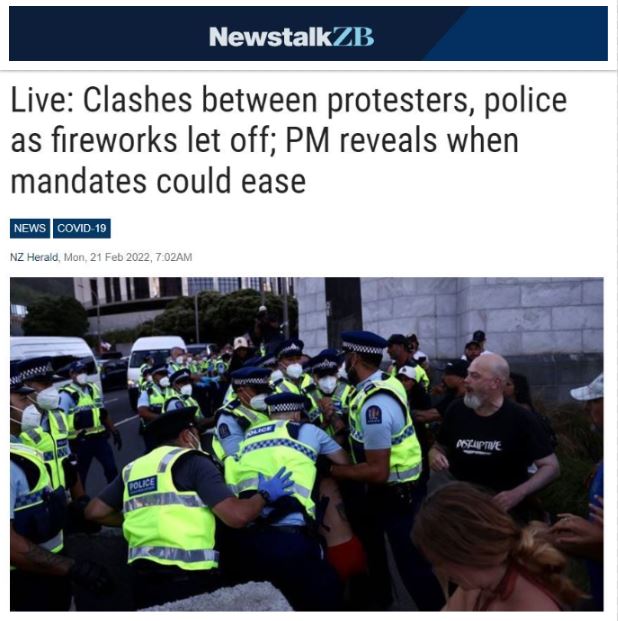
The Otago Daily Times reported Ardern claimed that her administration had upheld an “important separation” between the police and Government”, which had been republished from RNZ.
In the article headlined, PM: “I support police, time for protesters to go home”, Ardern was quoted:
“The law is very clear on this, and rightly so: Government cannot and should not ever be able to instruct the police as to how they enforce the law or when they enforce the law.”
This republished article failed to point out that the ODESC group had met to head off the threat of political dissent on the Government’s door-step. Moreover, in the RNZ interview ‘The point has been made’: Prime Minister Jacinda Ardern tells protesters to go home, the PM claimed the protesters had had their say.
This was factually wrong and this was not Ardern’s opinion. This was the PM’s brazen dismissal of New Zealanders who had travelled from all parts of the country. Ardern also gas-lighted RNZ’s news audience when she audaciously claimed that all of the trouble would be resolved if the protesters simply went home.

However, the protesters had occupied parliament in an attempt to force the Government to discuss the issues, to hear their testimonies and to lay out the counter-evidence on why they believed the Covid-mandates were inflicting more harm than good.
If Parliament is the place for a contest of ideas, perspectives and experiences to heard, with supporting evidence, along with testimonies of harms done by the Government’s policies, then it would appear that the Ardern Administration’s exercise of police force to remove such occupiers was arbitrary.
Since the arbitrary application of powers is one measure of a police state, I believe New Zealanders should be more distressed about the Ardern Administration’s convening of the ODESC group, the Ardern Cabinet’s attitude to political dissent and the willingness of executives at NZ Police HQ, 180 Molesworth Street, to upend a peaceful occupation with police disturbing the peace.
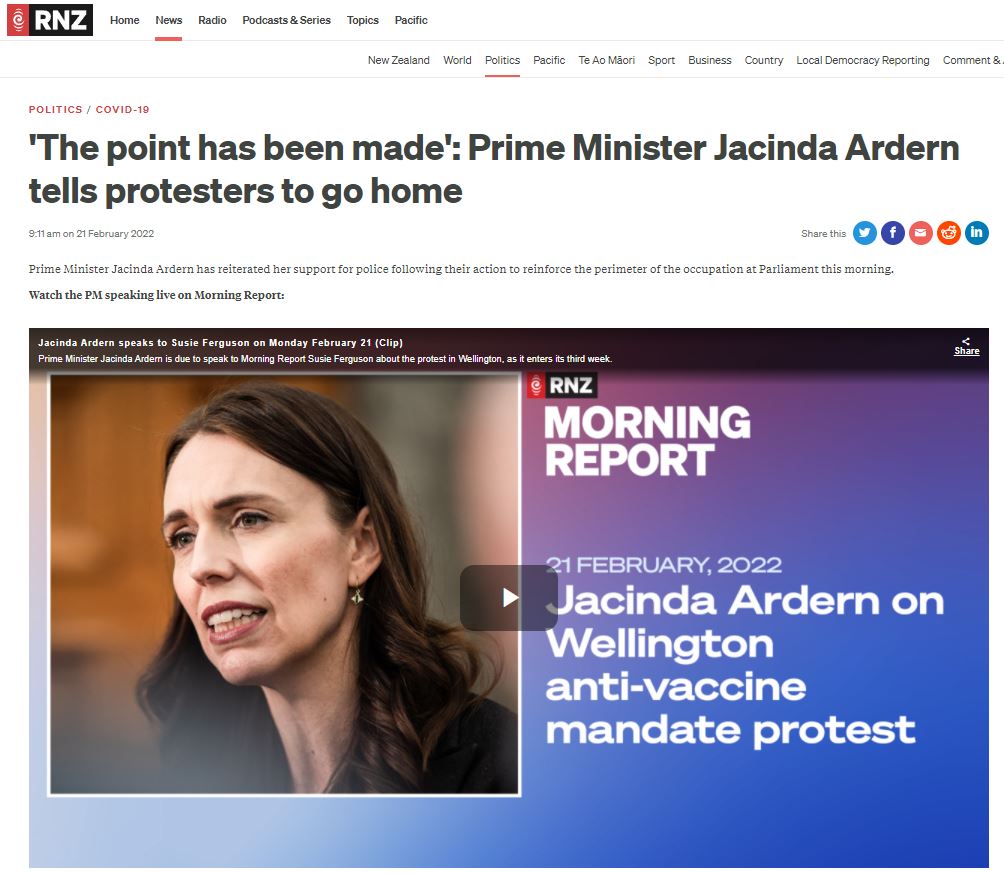
In an article, Occupation Day 14: Water bottle hurled at police during clash near Parliament, The Dominion Post failed to account for the police brutality that occurred when the police breached the peace at 3:30am on February 21 to commence laying bollards.
Shortly before 4am, ‘Freedom Village’ on Parliament Grounds awoke to the mantra ‘hold the line’, which is code for the camp to move in the direction of the calls. Approximately 50 New Zealand Police strode to the end of Kate Shepherd Place, where a stand-off ensued between about 100 anti-mandate occupiers and the Constabulary.
At approximately 4am, a truck bearing the corporate insignia of Lower Hutt-based, LT Transport Ltd, with a flat deck trailer and winch parked-up with its load of concrete blocks.
Kate Sheppard Place was the vehicular access for the outdoor kitchen server marquees located on Molesworth Street, which is the main street frontage to Parliament Grounds.
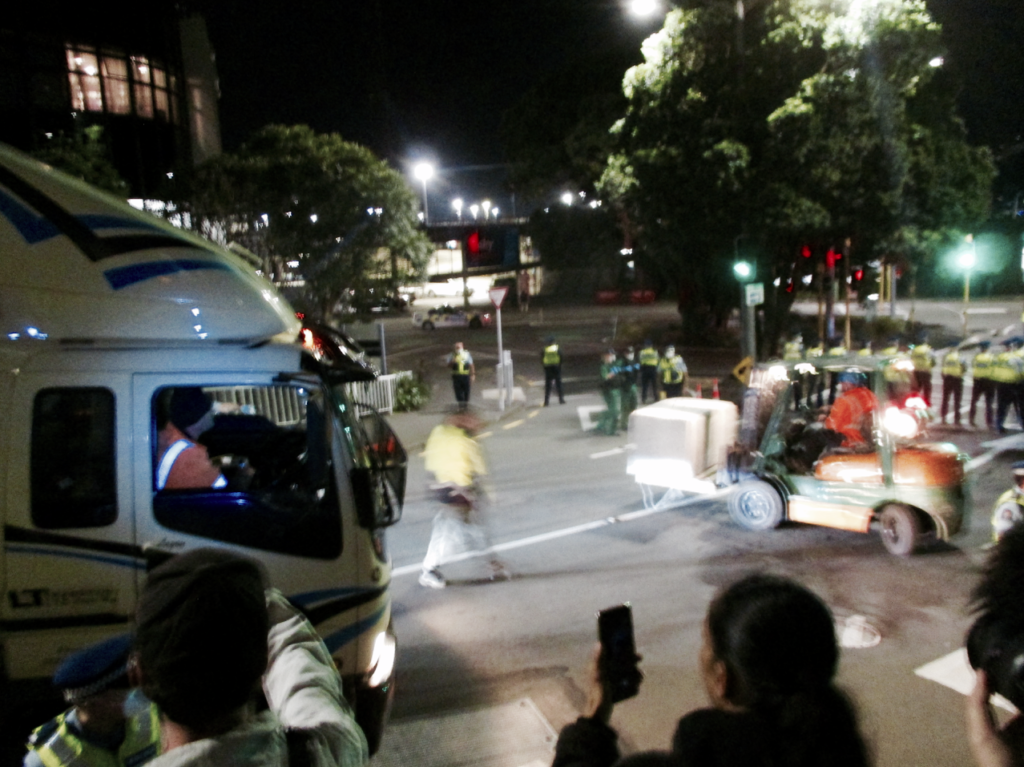
While a fork hoist driver set two blocks to partially block Kate Shepherd Place, and a police car completed the cordon, some among the protest group verbally abused the truck driver and fork lift operator, as well as police. Several protesters attempted to calm down the most agitated.
Three blocks were laid to partially block the bus depot exit next to Kate Sheppard Place, while another Police car was used to complete the cordon. The Bus Station and carpark became another auxilliary encampment since the anti-mandate occupation began on February 8th.
Next, the Police marched around corner to block off the intersection of Bunny Street at the Featherston Street end, which is located across from the Wellington Central Railway Station. In Bunny Street, there are numerous vehicles, tents and awnings that form one of several auxiliary encampments in the vicinity of New Zealand’s Parliament Grounds.
Four trucks from LT Transport and Hammond Crane & Cartage rolled up, amid 300 Police, and a noisy crowd of 250 Liberty Occupiers.
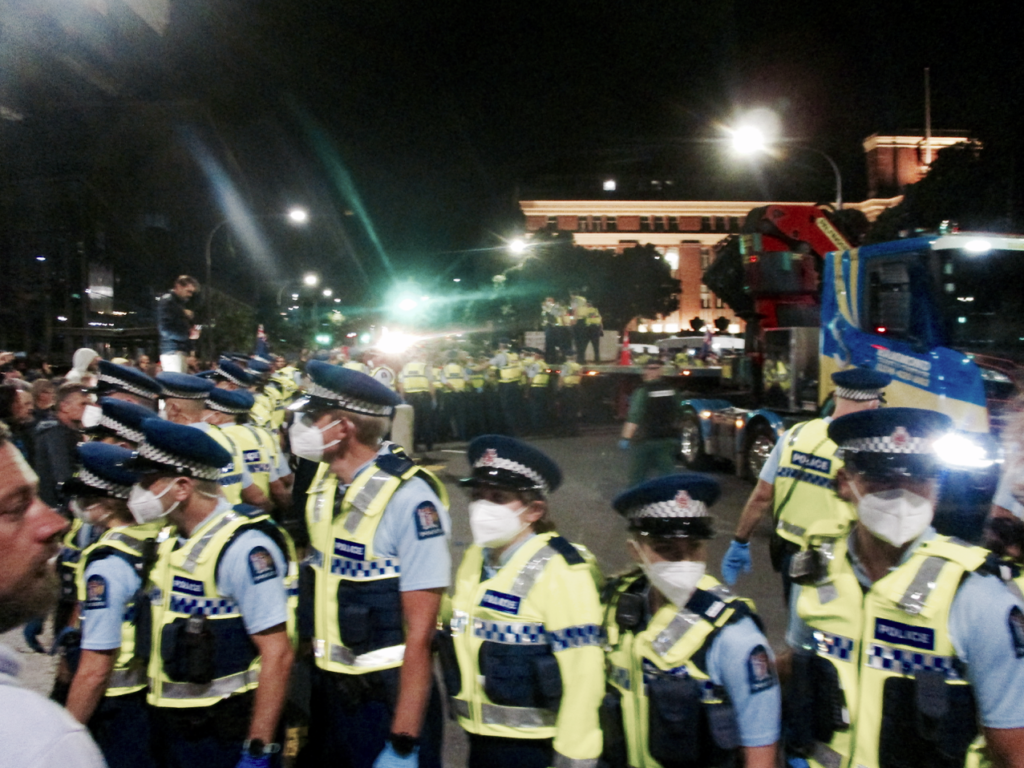
While two fork hoists zoomed back and forth to the trucks, the Police moved like parts of a machine to block the protesters, create space for the fork lift and tracks and the advancing trucks with their payloads of 15 half-tonne blocks.
Amidst this re-dawn activity, some protesters vented anger with expletives, ranting and cussing, while others spoke words of wisdom about occupiers protecting the freedom of New Zealanders — amid a couple outbreaks of shoving police.
Two men climbed onto the tail-end of a flat-bed trailer and sat facing one another on a concrete block. Police mounted the trailer and attempted to prize the men from the truck. Police quickly became frustrated that they could not easily prize the men apart, because they had locked their forearms together and clasped each other hands.
The police resorted to punching the mens’ faces and heads. The man at the back of the trailer was pushed over the side and he fell onto Featherston Street. The other man was dragged off the truck. The two men were among about 10 free range humans who were taken into police custody by the time the sun rose over the capital of this troubled South Pacific Realm.

After the 15 blocks were set in their places, the police marched around to block to the intersection of Lambton Quay, Bowen Street and Whitmore Street. At this intersection, police repeated their guerrilla warfare tactics of advancing to protect the placement of blocks.
A few wrestles between police and protesters occurred at this intersection.
One fraccas happened when the Constabulary pushed the crowd back to make space for the fork-hoist driver to lay blocks to close off the turning lane from Whitmore Street into Bowen Street by the Masonic War Memorial Cenotaph, below the Masonic Beehive.
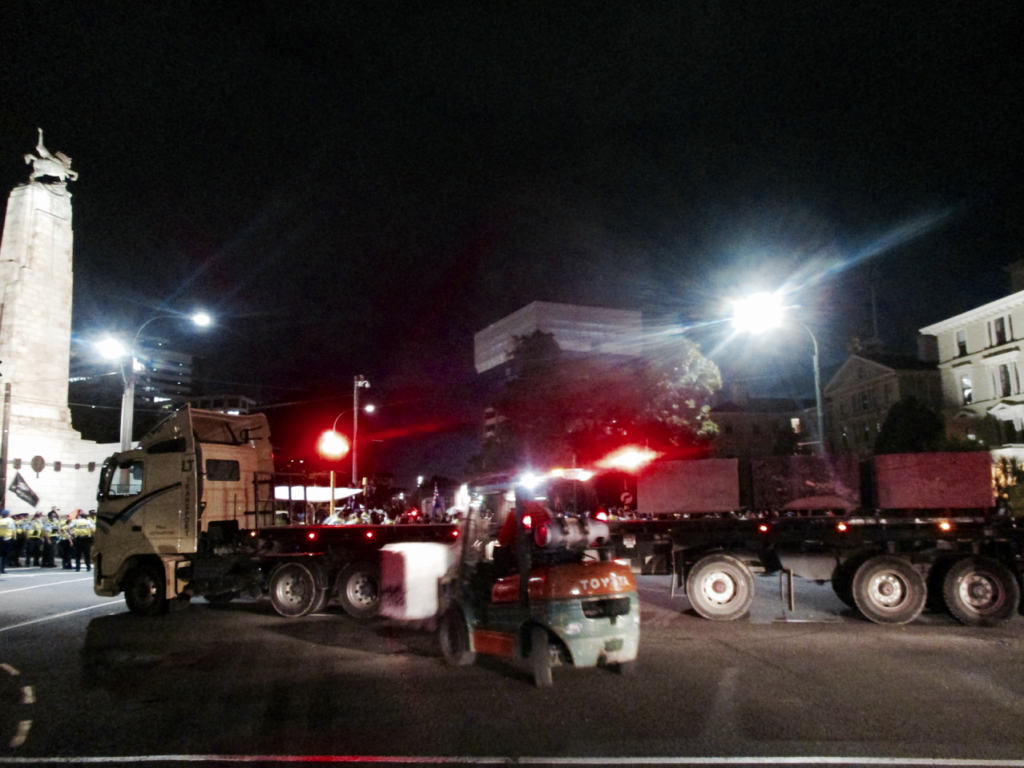
By blocking off Bowen Street, Police cut off access to the port-o-loos with the effect of possibly choking service to the portable toilets, or choking the growth of the occupation. (Earlier, Police had constructed a cordon at the far end of Molesworth Street, with a few bollards and a police car).
The clashes between police and protesters was construed by the news media to make it appear that the protesters had instigated the violence.
Prominent brands of New Zealand’s media cartel, such as The New Zealand Herald, The Dominion Post, 1News, Newshub, NewsTalkZB, and Radio NZ and the Otago Daily Times failed to accurately describe the cluster of events as the concrete barriers were deployed around the streets.
Ironically, the dawn blockade operation to cut-off the supply chain of occupying Freedom Force in the capital city, is in keeping with the New Zealand’s historical violent state formation, given that such guerrilla warfare tactics were used by British, Colonial and Constabulary forces during the New Zealand Masonic Revolutionary War of 1860-72.
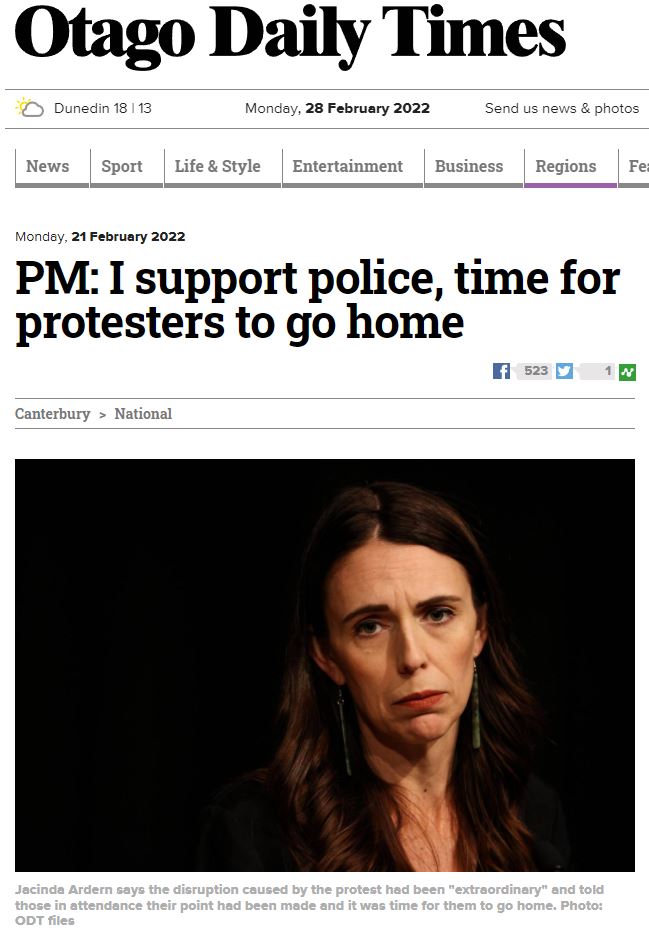
By early morning, the level-headed among those comprising Freedom Village viewed the mornings events as problems that could be matched with solutions, since the composition of the occupation is mostly working class people who are used to challenges.
However, an escalation in the National Security State’s siege strategy occurred the following morning – this time with the Establishment Media present.
Tuesday 22 February 2022, Wellington NZ
Prominent brands of New Zealand’s media cartel, such as The New Zealand Herald, The Dominion Post, 1News, Newshub, NewsTalkZB and Radio NZ failed to accurately describe the cluster of events at Molesworth Street, Tuesday 22 February 2022.
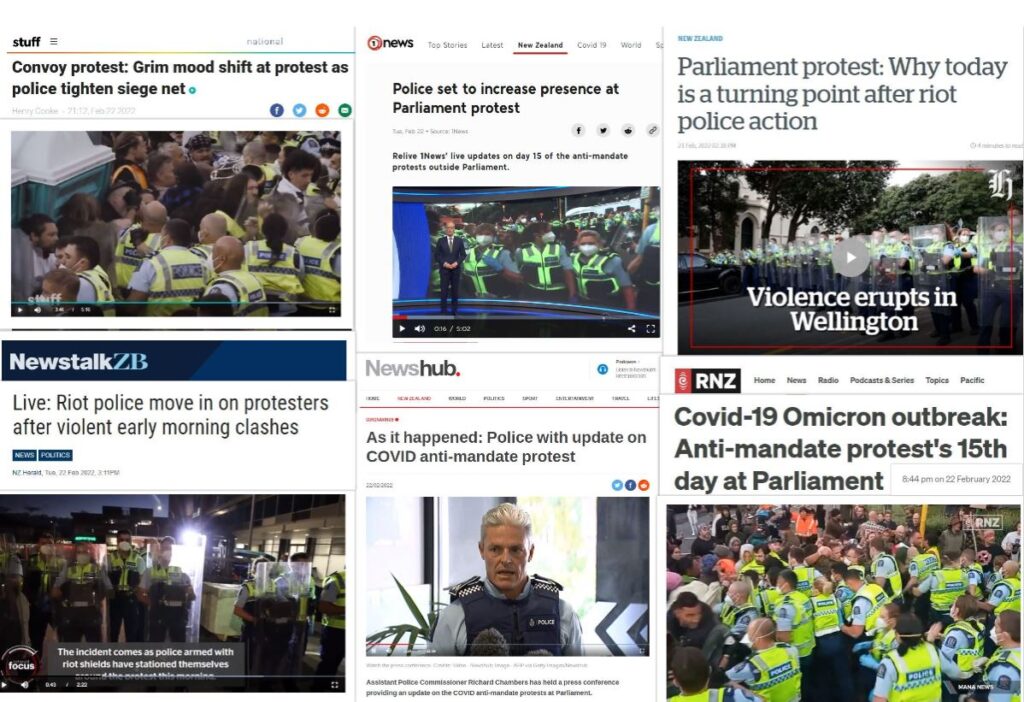
In doing so, they served as platforms for the police propaganda to re-win control over the battle of the narrative.
Twenty-five police brandishing riots shields ran at a group of anti-mandate protesters positioned next to the Parliament Grounds at 13 minutes to seven in the morning.

As the police ran down the footpath below me from my vantage point of the forecourt at the Archives New Zealand building, I heard the riot-shielded police command provocatively, “Move, move, move,” repeatedly.

Within a minute, a fraccus broke out — as the Police intended — when they pushed forward forcing protesters against a cluster of port-o-loos on Molesworth Street outside the north eastern boundary of Parliament Grounds.
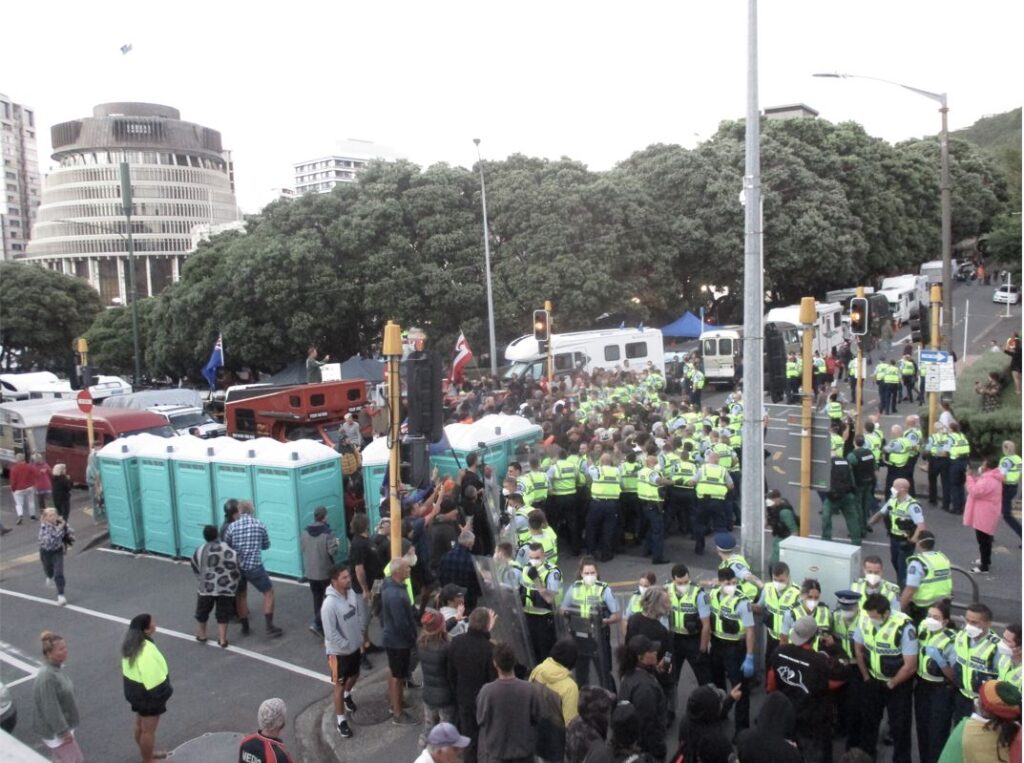
A more aggressive team of police had surged forward, squeezing protesters against the port-o-loos, one another and nearby vehicles. This action further agitated the protesters.
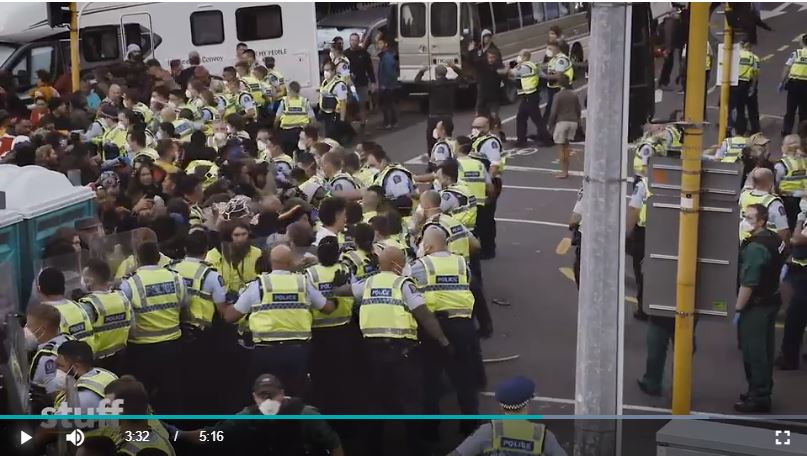
The aggressive re-appearance of the police with riot shields followed a five minute lull.
During the five minute lull, some police moved to the intersection of Molesworth, Hill and Aitken streets where the port-a-loos were located. The riot-shielded police formed a semi-circle.
More police rushed forward as the clash erupted.
One police officer appeared to eye gouge a parliamentary protester, Phil Peters, after the same policeman punched him.
To their credit, The Dominion Post followed up with a story headlined — Protester claims police punched and eye-gouged him at Parliament occupation — the next day. The report featured parliamentary protester, Phil Peters, who claimed he was punched by police and eye gouged — during the fracas early on Tuesday morning.
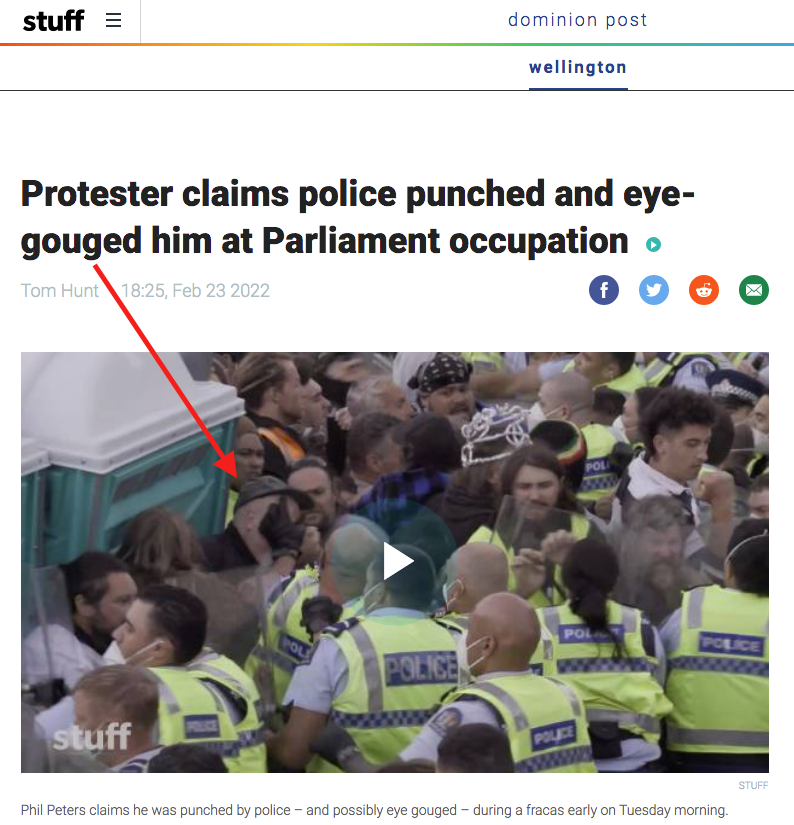
The black gloved police officer appeared to use his left thumb at least twice to eye gouge Mr Peters, between punching him with his hand in the face and abdomen.
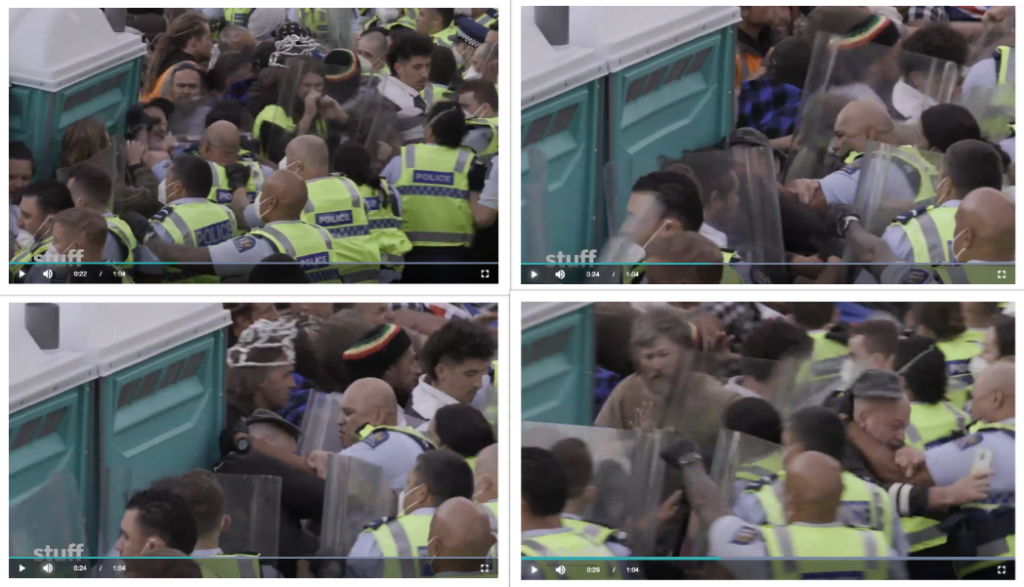
One policeman was armed with a wooden stick, which he discarded as he moved forward to assist the black-gloved eye-gouger policeman wrestle Mr Peters to the ground in front of the port-o-loos.
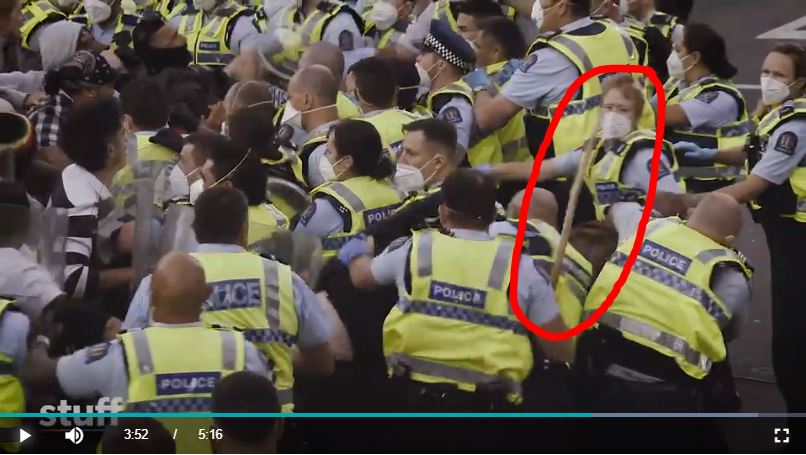
This brandishing of a stick adds weight to my contention that the police were looking for a fight to make the morning news with propaganda that a riot squad was required to quell aggressive protesters.
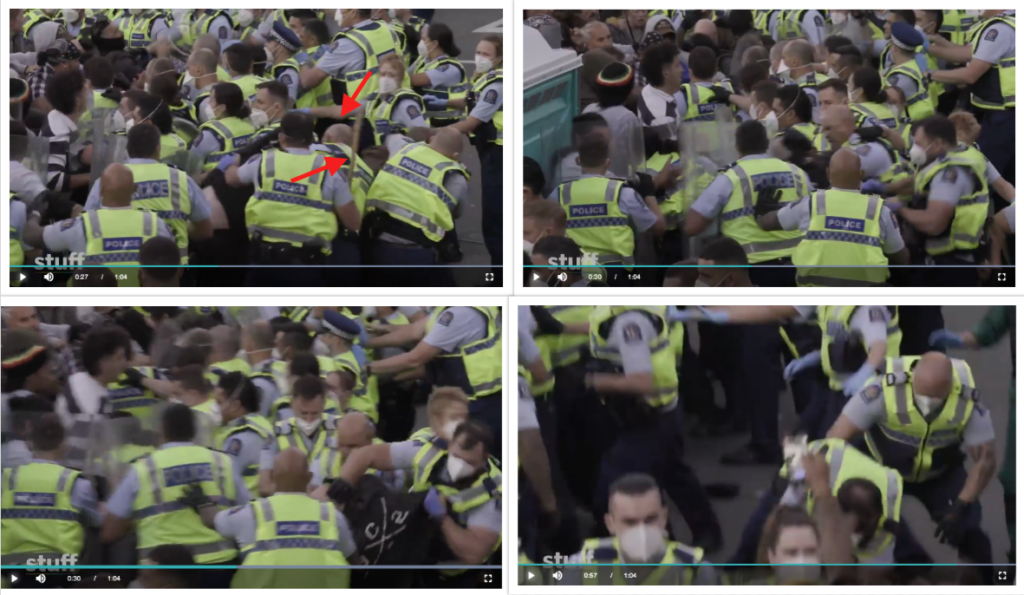
Moments before, another mandate resister was wrestled to the asphalt.
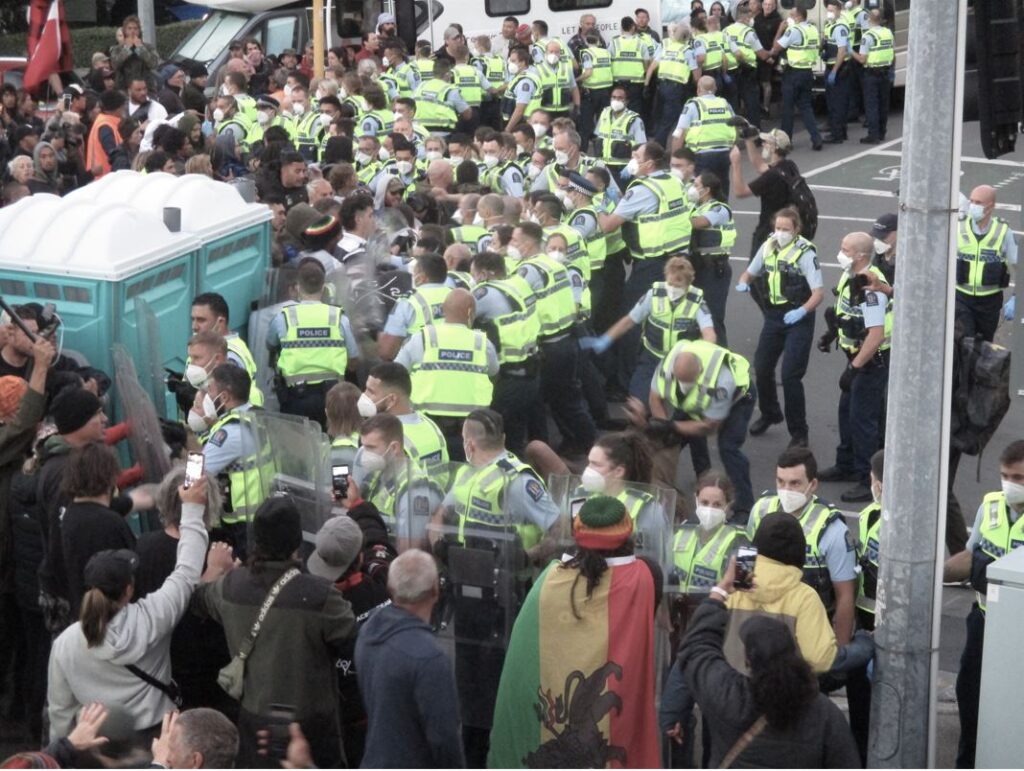
Earlier, at around 6:35am, a fork-hoist was used to transport the first of two blocks to partially cordon off Molesworth Street and footpath by the Archives New Zealand Building. The first block was placed on the footpath.
Police with riot-shields jogged behind the forklift as it advanced along Molesworth Street.
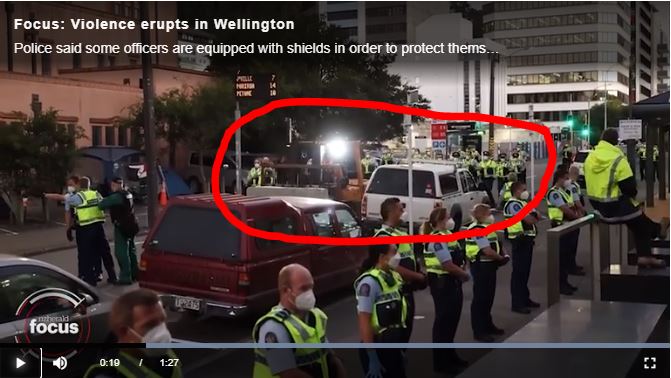
Between the first and second concrete block being laid, a white car drove along Molesworth Street toward the frontline as extra police stood at either edge. The white car decelerated, then came to a stop, without injuring anyone.
The driver was handcuffed and taken away.
Police have yet to explain where the driver of the white car came from and whether he had breached the police cordon further down Molesworth Street, especially given that Police National Headquarters is at 180 Molesworth Street.
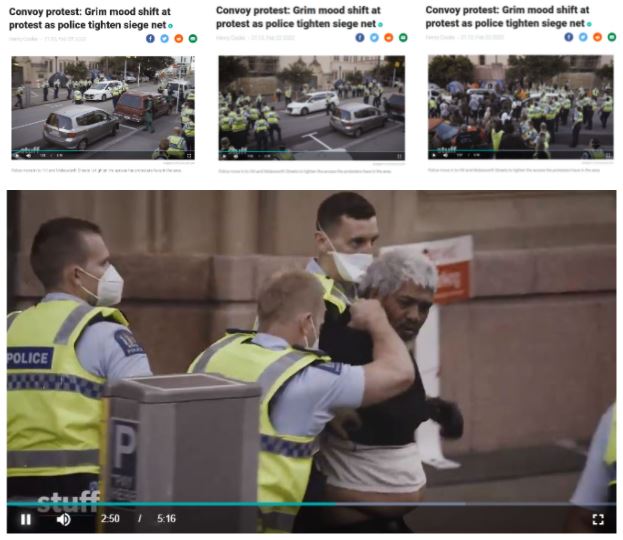
Meanwhile, the police frontline on Molesworth Street waited.
And the 25 police with riot shields were standing by, at back end of the Archives New Zealand building [marked with red ring]. These riot police were not used to support the forklift delivering the second bollard.
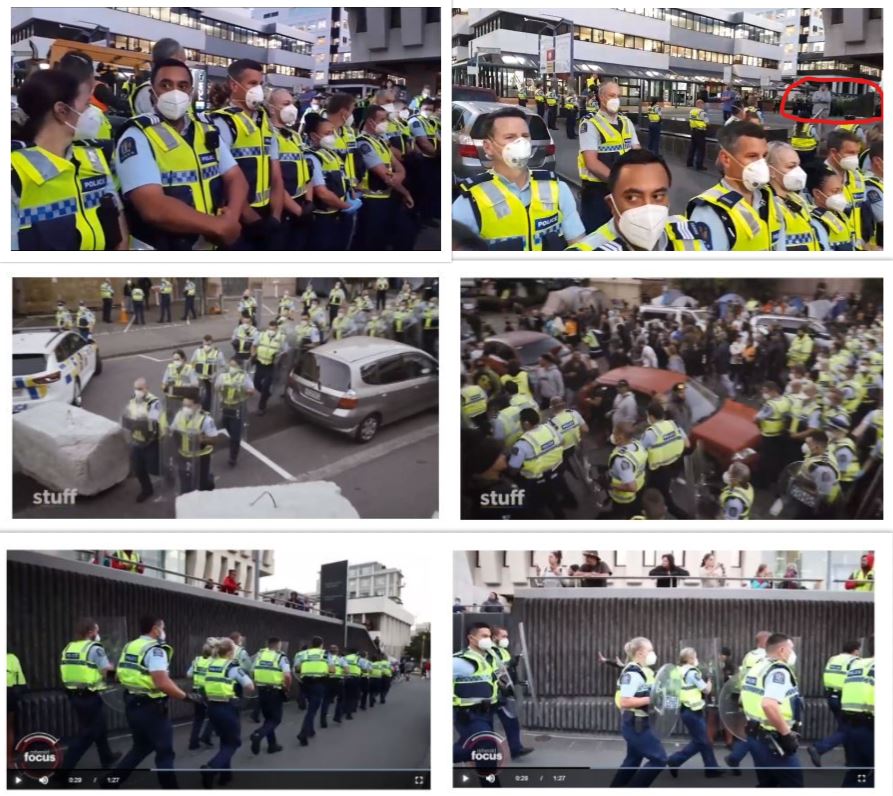
Conveniently, several news cameramen, or freelance stringers, were spotted filming in the early morning light gathering images for the hungry breakfast news programming.
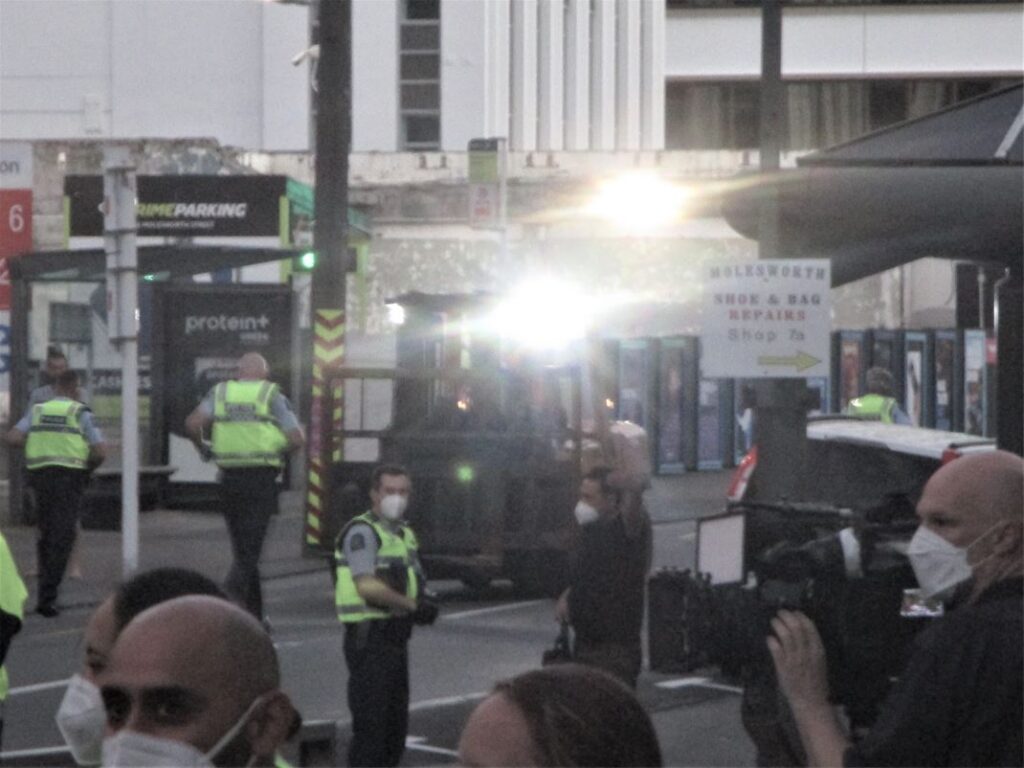
The previous morning — during which 300 police managed a siege operation, which began minutes before 4am, to cordon off five access points of streets surrounding the Parliament Occupation, including Molesworth Street — there were fewer news cameras.
The use of the riot police was construed by the news media to make it appear that the protesters had instigated the violence.
However, the five minute lull during which the positioning of some police at the intersection where the port-o-loos were located, and then the sudden rush of the riot police into position — indicates that the police commanders’ objective was to incite violence.
A sanctimonious Assistant Police Commissioner Richard Chambers positioned police as doing their best to maintain the peace.
With such a fraudulent posture — that was a breach of section 240 of the Crimes Act which deals with crimes of deceit — Assistant Commissioner Chambers claimed the protesters’ behavior was “disgraceful”.
New Zealand’s Prime Minister, Jacinda Ardern also framed the protesters’ actions as disgraceful.
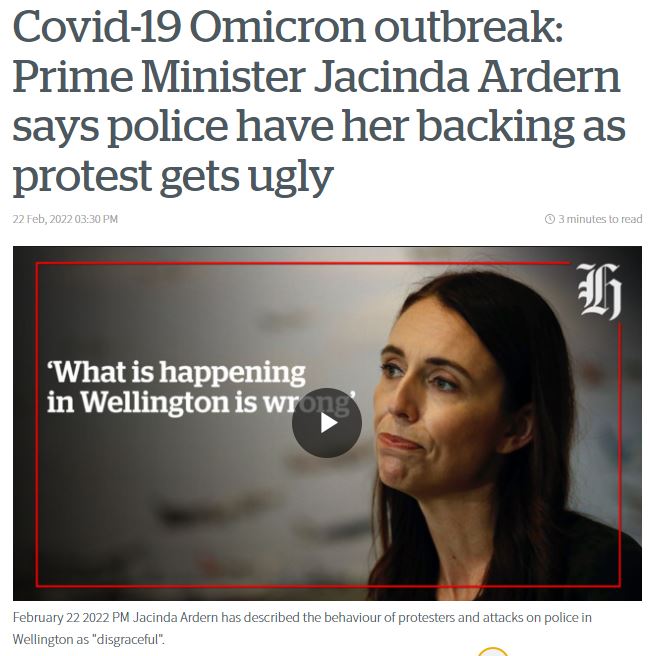
Because the NZ Police command, the government executive and Wellington’s political élite could be confident that New Zealand’s media missionaries would again fail to truthfully report the clustered events as they had actually unfolded — such élites were able to extend their control over the occupation narrative.
In this way, Assistant Police Commissioner Richard Chambers — who wore a street operations vest — emotionally hijacked news audiences when he claimed the actions of protesters were “disgraceful”.
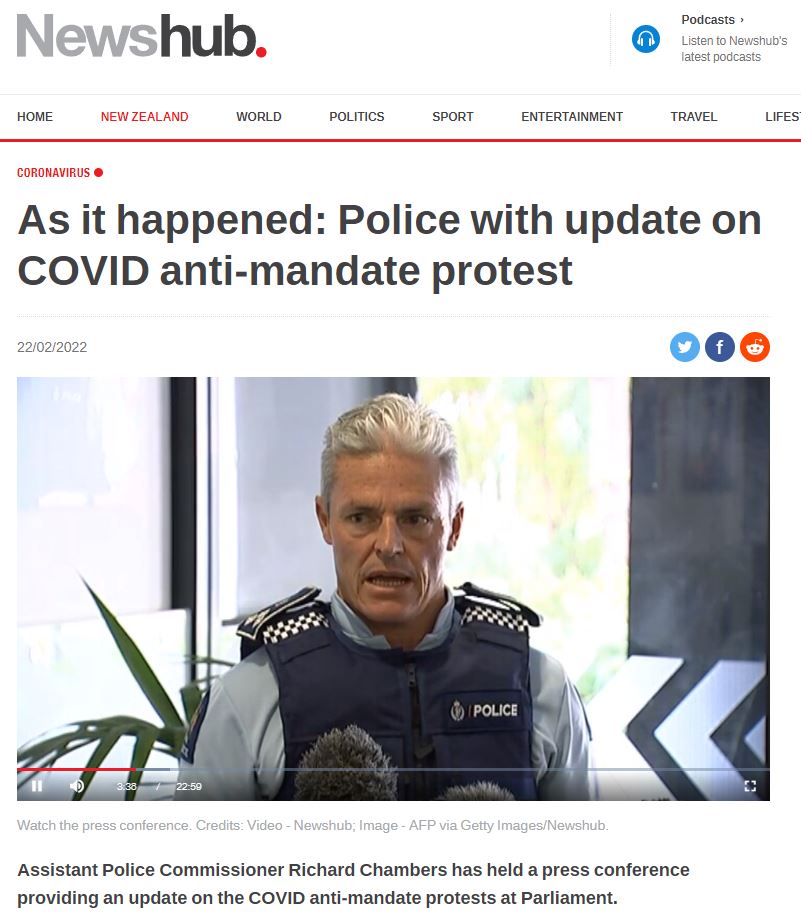
This state-sponsored subversion of the occupation — which is the key bargaining chip of the protesters — is a continuation of the baiting, violence and breach of peace inflicted by police the previous morning, when the bollards were placed to choke access points, as well as the arrests of Day 3, Thursday 10 February.
The Police command well know that five percent of the occupation group lack the ability to maintain control of their emotions, and instead could be easily baited to re-act out old scenes of personal crisis in these newly plotted scenes.
There was no strategic value for the Police to push forward to win control of the port-o-loos at that time. The police would have looked like assholes if they had won and cordoned off the portable toilets.
As Snoopman News reported February 23, in a dispatch headlined — Police Incite Violence to Bait Protesters for Breakfast News Propaganda — the deployment of police with riot shields seeded the narrative that the resistance had become more violent.
Wednesday 2 March 2022, Termination Stage of Siege Strategy
Prominent brands of New Zealand’s media cartel, such as The New Zealand Herald, Stuff’s Dominion Post, 1News, Newshub, NewsTalkZB and Radio NZ failed to accurately locate the cluster of events of Wednesday 2 March 2022 as the culmination of Jacinda Ardern’s Cabinet’s refusal to engage in discussion with the Liberty Occupation.
Because, the news media had already chosen to side with the Ardern Government, the framing of news coverage, reinforced the police actions to forcibly upend the Freedom Village as a legitimate course of action.
The subsequent violence that occurred was mostly blamed on protesters, as well as the fires and damage to the neighboring Victoria University campus. The news media took Police Commissioner Andrew Coster at his word that the make-up of the Occupation Group had changed over the previous week, whereby he asserted a violent element had moved in, and the various leaders of groups had lost control.
Like the news media — who frequently under-reported the occupation numbers — Coster inaccurately claimed there were only 300 people remaining at the time that the termination stage was commenced. There were between 2000 to 3000 humans camping in the occupied zone on Monday 28 February.
Those numbers dropped overnight on Tuesday 1 March following an announcement by activist and legal counsel Sue Grey at 5pm, when she stated on the stage that a force of 600 police had been assembled with riot gear, pepper spray and tear gas to inflict a raid. Many people moved out and the dinner tents were eerily quiet that evening.
The leaking of such news doubtless assisted the ‘de-escalation option’ that Andrew Coster frequently mentioned, which was code for choking the growth of the groundswell to make the siege strategy successful.
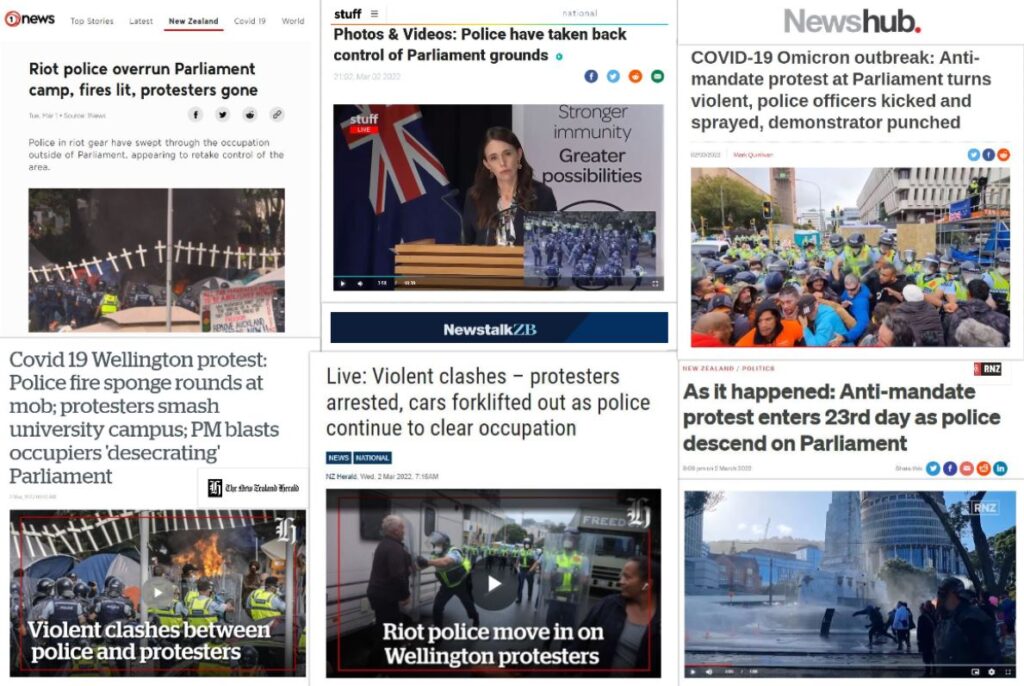
Because the news media had been complicit in the police breaching the peace on February 10, 21 and 22, NZ’s media cartel failed to call-out Coster, Ardern and the ODESC group for pursuing a strategy to choke the growth of the Occupation, breach the peace to produce bad optics for the protesters and make accusations without supplying evidence.
Predictably, New Zealand’s Prime Minister Jacinda Ardern sanctimoniously blamed the day’s violence, fires and arrests on protesters whom she claimed were among a small portion of New Zealanders who had come to believe wild and dangerous conspiracy theories.
By tacitly or explicitly authorizing this siege strategy as the Minister of National Security and Intelligence, Ardern was able to sanctimoniously claim the political, legal and moral high ground when she gas-lighted New Zealanders, saying:
“It was an attack on our frontline police. It was an attack on our Parliament. It was an attack on our values, and it was wrong.”
The seven police who were injured were cast as worthy victims for public sympathy, while injuries to humans deemed as protesters were for the most part, framed as unworthy victims — as Noam Chomsky’s Propaganda Model predicts.
Ardern also emotionally hijacked the New Zealand people by claiming that the small number of people on Parliament’s lawn were less than the number of people whose lives were saved by the pandemic measures her government had taken on the last two years.
The New Zealand Herald reported a sanctimonious Coster claiming, “This has never been about preventing lawful protest.” This was not Coster’s opinion. It was an inoculation tactic.
Coster gas-lighted New Zealanders by justifying the major operation following an escalation in concerning behaviour, and the protest had reached a stage where the harm being done far outweighed any legitimate protest.
The New Zealand Herald — like the rest of the mainstream news media — failed to call-out Coster, Ardern and Mallard et al for pursuing a strategy to choke the growth of the Occupation, breach the peace to produce bad optics for the protest group and make accusations without supplying evidence.
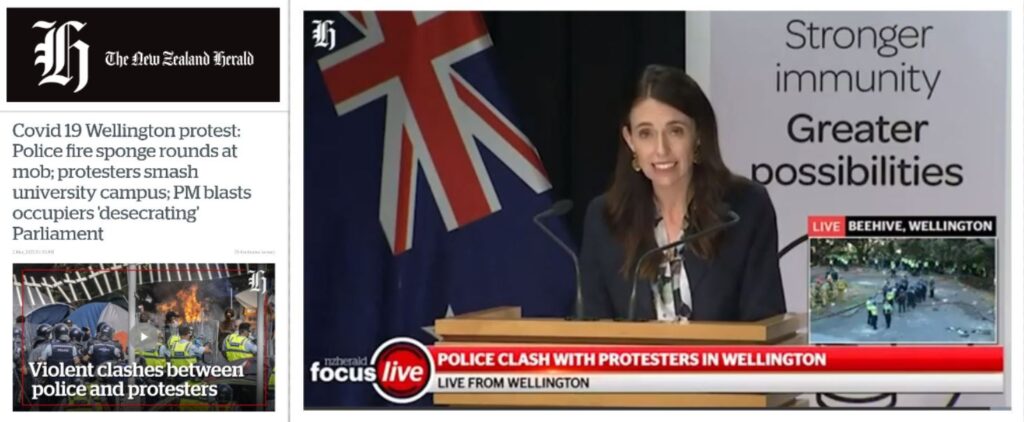
In a New Zealand Herald article headlined, Covid-19 Wellington protest: Police storm occupation site – tents on fire, slide torched as Parliament lawn cleared, the framing with the headline, imagery and video commentary created the misleading impression that the police stormed the parliament occupation once tents were set on fire.

The New Zealand Herald also reported:
“A large group of officers in riot gear and body armour gathered outside the Parliamentary Library complex and then began advancing on the main occupation site on Parliament’s lawn, sparking fresh skirmishes just before 2.30pm.“
With this short description, The Herald avoided explaining the riot-clad police led a charge at protesters, before pepper spraying, beating and arresting many over a 15 to 20 minute period, before advancing forward to demolish the camp.

People retaliated with bursts of fire extinguishers, lobbing objects and cussing.
Reports by TVNZ’s 1News such as “Riot police overrun Parliament camp, fires lit, protesters gone” also failed to supply context that the police siege strategy actioned since the deployment of bollards on February 21, amounted to state-sponsored breaches the peace. The shift in ‘balance’ with more people infiltrating the peaceful occupation in the remaining days was a direct result of this police siege strategy.
The Crown-owned broadcaster reported Ardern’s sanctimonious rhetoric without any critical counter-voices in an article headlined, PM saddened to see Parliament ‘desecrated’ by protest violence, to quote from her manipulative press conference.
In ‘High’ police presence expected overnight at Parliament, the 1News website carried a live-cross performed by Jessica Mutch standing on a balcony of the Beehive during Seven Sharp. Mutch described the ruined property of the protesters as detritus and rubbish, thereby framing the Occupation Group as criminal vagabonds unworthy of public sympathy.
Jeremy Wells legitimized the police actions by expressing there had been a concern that confronting protesters would incite violence, rather than framing the police strategy as a siege that was inherently about breaching the peace.
Mutch claimed the police had taken a “softly, softly approach” which worked as an double entendre since Softly, Softly was British police TV series that ran for a decade from 1966. She failed to call out the Cabinet, ODESC and Andrew Coster for pursuing the siege strategy to upend an occupation, which was the peoples’ peaceful expression of opposition to the New Zealand Parliament’s ongoing Covid mandates.
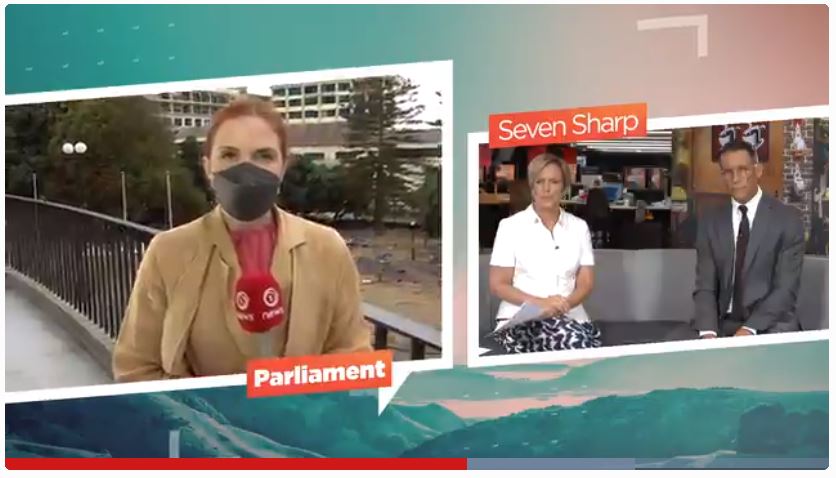
Lost in transmission, therefore, were the actual issues being contested, as well as the community spirit that thrived for 22 days to construct a village and the critical importance of a citizenry maintaining the capacity to stage an occupation.
In The Dominion Post‘s story, Protesters disperse after major police operation ends Parliament occupation, André Chumko, George Block and Erin Gourley failed to call-out Police Commissioner Coster, who gas-lighted New Zealanders when he claimed the police action of March 2 was the result of a change in the make-up of the crowd of protesters and an escalation in concerning behaviour.
Ironically, Stuff — which owns The Dominion Post — was among the few news-outlets that had reported Thursday 17 February in “National security crisis group meets as Parliament protests continues”, that the ODESC group had been convened following the failure of police to eject the occupation Thursday 10 February.
In Stuff‘s compilation, “Photos & Videos: Police have taken back control of Parliament grounds” the newspaper group also failed to provide context that it was the police that instigated the breaches of peace by escalating their siege strategy from 6am Wednesday March 2nd.
With their headline, “Anti-mandate protest at Parliament turns violent, police officers kicked and sprayed, demonstrator punched”, Newshub also framed the cause of the violence originated with the protesters.
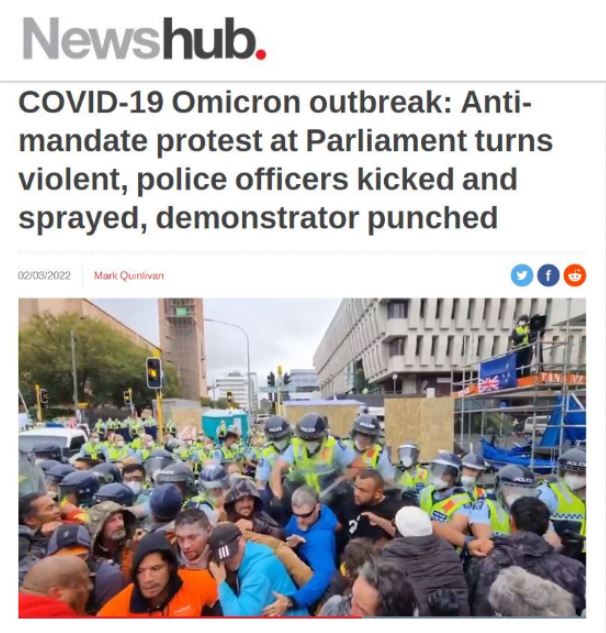
Ironically, for New Zealanders old enough to remember, Newshub‘s Zane Small also reported Thursday 17 February that the ODESC group had been convened to discuss the ongoing occupation.
Moreover, Newshub has also reported Police Commissioner Andrew Coster had on Tuesday 15 February activated a Major Operations Centre at Police National Headquarters in Wellington to support the operation “following ongoing protest activity that is unreasonably impacting the city”.
Newshub did not contest Coster’s place to be, in effect, one of the presiding judges — along with Mallard, Ardern and the ODESC group — to decide why a protest that took the form of an occupation should not impact the capital city.
After-all, disruption to commerce, politics and the social life of the people is a key means for effective protest to coerce the powerful to get down off from their high-horses.
Moreover, New Zealand’s response to the Covid-19 ‘pandemic’ was (and remains) disproportionate to the threat because the Government failed to model for the possibility that the nation might be gamed in a future hostile geo-political strategy.
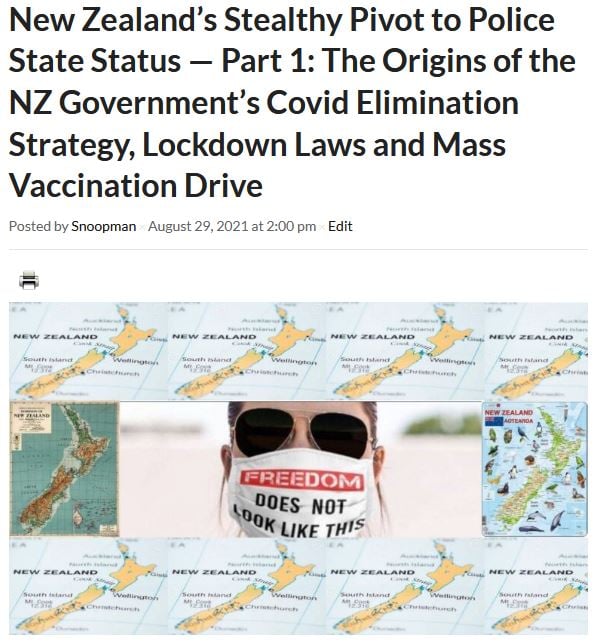
We are now two years into the crisis that the World Health Organization dubbed a global pandemic on March 11 2020 — at a time when the world Covid-19 death toll was under 5000 people — and yet no officials across the New Zealand Government apparatus has actually investigated whether or not the nation has been played in a geo-political game.
In my heretical first Letter to the Future from the ‘Time of The Crazy’, I outlined counter-factuals that point to a racketeering transnational syndicate of Corona Bandits.
I also sketched the ‘anatomy of resets’ as mechanisms of deep state-planned events to alter the trajectory of a society, and I located the Great Corona Reset as an attempted global coup d’état to establish a Techno-Feudal Totalitarian World Order and I also signaled the big picture trajectory humanity is headed — unless humanity is quick enough and successful at dismantling the turn-key totalitarianism.
In an article, Violent clashes – protesters arrested, cars forklifted out as police continue to clear occupation, NewtalkZB assumed that the underlying justification for the continuation of health measures were necessary — along with the other news outlets — since none of them had bothered to conduct any sustained serious investigations of the counter-evidence.
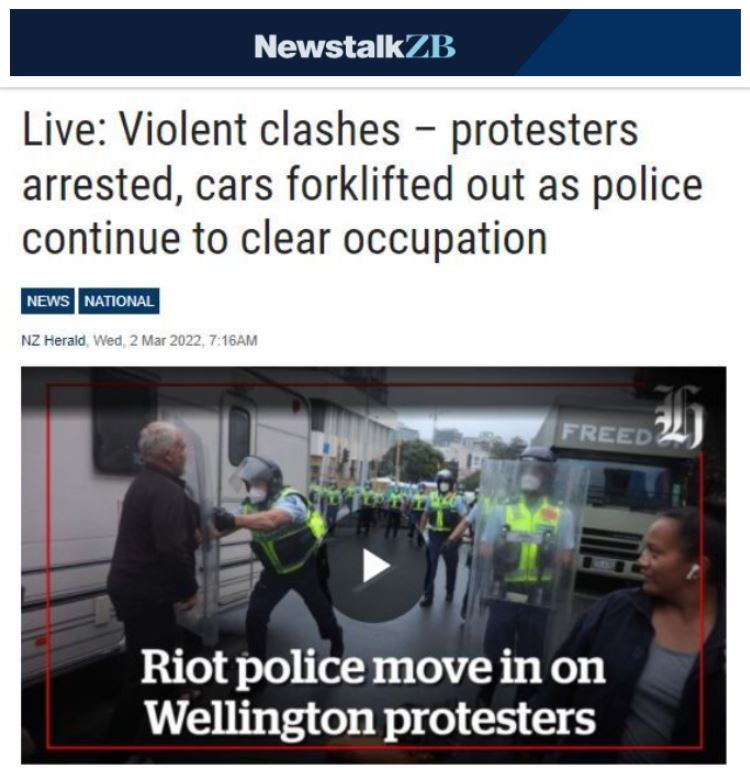
In their March 2 account, NewtalkZB failed the cast the police siege as an arbitrary wielding of state power to put down political dissent, and in effect gave the last word to the Director General of Health, Dr Ashley Bloomfield. NewtalkZB reported that Bloomfield said it was “irresponsible” for those involved in the Parliamentary occupation to tell people to shun public health advice.
And yet, for two years, Dr Bloomfield has been one of the key officials who has overseen the infliction of measures disproportionate to the threat, when more targeted public health measures to take care of the old, sick and otherwise vulnerable people, would have been a sound, wise and lawful approach.
Instead, Bloomfield participated in the infliction of Medical Martial Law and was assisted in that unsound course by New Zealand’s media cartel who acted as a vector for spreading a contagion of fear porn news amid a global propaganda pandemic that over-hyped the health threat.
Acting as a check on abuses of power, is after-all, the marketed purposed of media journalism, as every newsroom that has won investigative awards will boast. And yet, for two years, New Zealanders have been asked, along with much of the Western world, to tolerate incursions into their daily lives that most would have thought only possible in the police state of Russia or in totalitarian China.
In essence, the peoples of Western ‘liberal democracies’ have been subtly cast as Covid suspects while being asked to believe the ironically childish notion that public health is the only sector immune from corruption, conniving and collusion.
Radio New Zealand’s compilation timelines, Police move against Parliament protesters and Anti-mandate protest enters 23rd day as police descend on Parliament, also failed to accurately report the police-instigated violence, despite going to the effort of recording times.
And in spite of capturing the presence of a police paramilitary SUV from one of the Special Tactics Group, who are trained in counter-terrorism, RNZ neglected to question why the police force’s paramilitary squads were even necessary.
Given the onus is on politicians to discuss differences — especially at moments when political dissent becomes so elevated — one would have thought reporters at RNZ would have relished the opportunity call out Ardern, her deputy Grant Robertson, and Mallard, since the sudden appearance of ‘riot police’ on February 22.
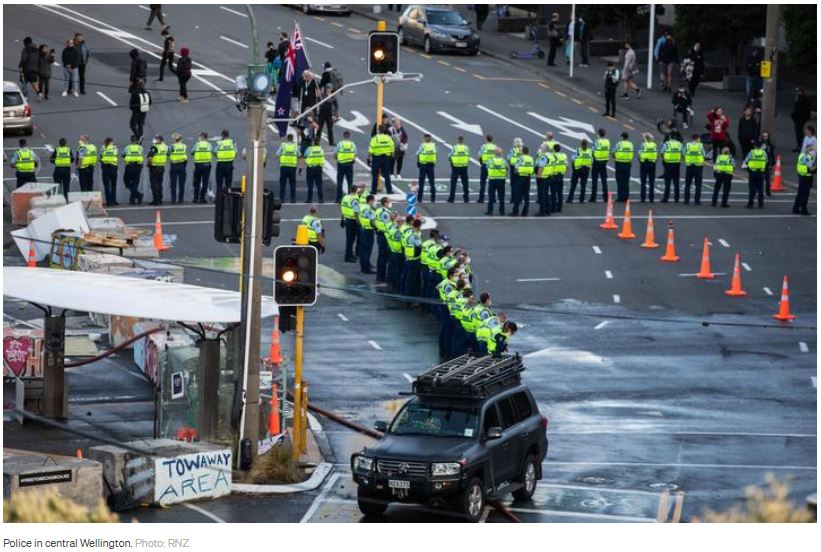
Especially, since Ardern’s rhetoric on election night 2020 saw her claiming that New Zealand was above allowing itself to become closed-minded in an increasingly polarized world.
Ardrern said:
“We are living in an increasingly polarized world. A place where people have lost the ability to hear one another’s point of view. I hope that [with] this election, New Zealand has shown this is not who were are. That as a nation, we can listen and we can debate. After all, we are too small to lose sight of other people’s perspective.”
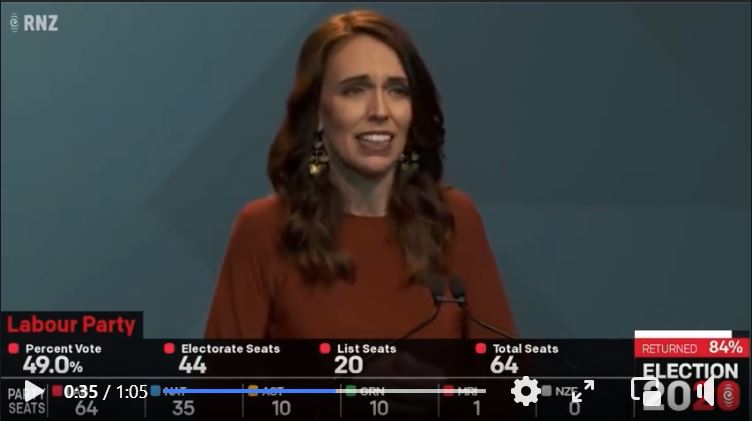
Clichéd Sanctimonious Deflection of Blame from Gaslighting Central
Predictably, New Zealand’s Prime Minister Jacinda Ardern sanctimoniously blamed the day’s violence, fires and arrests events on protesters whom she claimed were among a small portion of New Zealanders who had come to believe wild and dangerous conspiracy theories.

However, it is the New Zealand Government along with the United Nation’s other member states who have spread a contagion of propaganda while they refuse to supply open inquiries to hear the counter-evidence that would prove there is no pandemic of the scale purported.
The Great Corona Reset measures that were inflicted from 2020 onward have set in motion the conditions for an ongoing hybrid war that most do not yet comprehend as World War III. The inbuilt escalating crises were inflicted to accumulate more power, wealth and control for the global élite — as The Snoopman sketched his first dispatch of a series entitled Letters to the Future from the Time of The Crazy.
The following morning, Police Commissioner Andrew Coster sanctimoniously blamed a small number of protesters who were spoiling for a fight, rather than admit the planning underpinning the siege strategy involved the use of police provocations, police brutality and police propaganda to create bad optics for the Freedom Occupation.
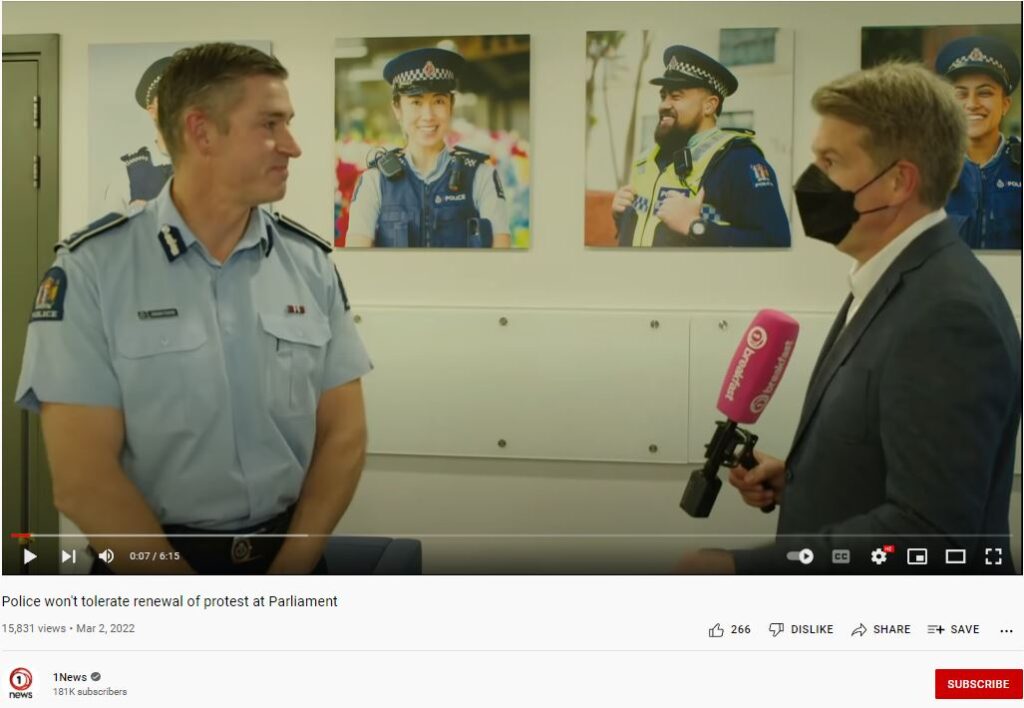
The siege strategy was designed to diminish the growth and precipitate a decline in numbers as well as attack public sympathy in order to support the Government’s decision to refuse to talk with the Freedom Occupation, as I showed in my fourth Wellington dispatch, Police Incite Violence to Bait Protesters for Breakfast News Propaganda.
On Wednesday February 23, the capital city’s morning newspaper, The Dominion Post, published an opinion piece penned by former Deputy Prime Minister in the Lange Government (1984-1989), Geoffrey Palmer — “Peace, order and disorder” — as I reported in my fifth dispatch, Major Chink in NZ Govt’s Armor as Police and Military Mandates Ruled Unlawful. This piece did not bode well for the occupiers.
Palmer claimed New Zealand as a sovereign state possesses “a monopoly over the legitimate use of physical force within its territory.” He added that the Bill of Rights 1990 does not allow for absolute rights to freedom of peaceful assembly, freedom of association and freedom of movement.
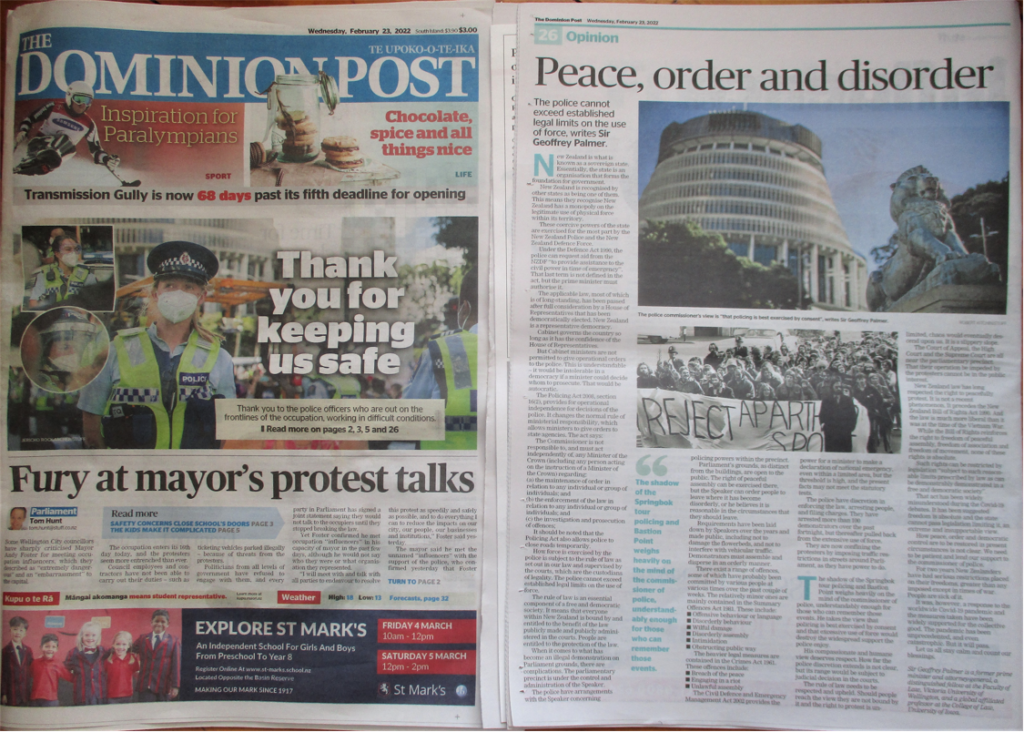
With this chess move, the Wellington Political Élite had recruited Palmer to legitimize state violence. Crucially, Palmer played a key role in limiting the fall-out with the French Government over the bombing of Greenpeace’s Pacific flagship, the Rainbow Warrior, in 1985, as I showed in ‘Price of Power’ Themed-Terrorism. In this way, an Official from Crisis-Past was used to justify state sanctioned violence — rather than a current official — to supply respectability, construe lawfulness, and save face for the Government.
In short, New Zealand has pivoted into a totalitarian police state in order to avoid a genuine review of the government’s implementation of the domestic version of a global biosecurity system under the rubric of the Great Corona Hostage Crisis.
Key Finding: NZ Newsrooms Complicit with Arbitrary Exercise of Police State Powers
I find, therefore, New Zealand’s mainstream newsrooms breached standards of accuracy, fairness, balance, discrimination and denigration and violence by failing to call out the Ardern Administration’s out of hand dismissal of the Freedom Occupation from the get-go, by tacitly valorizing the violence inflicted against peacefully protesting New Zealanders by police who claimed to be asserting law and order, but instead were practicing discrimination and denigration to save face for the Government.

I also find that New Zealand’s media acted as a cartel since they all failed to supply serious flak back at the government in their lead story headlines, bulletins and opening news intros, for such an obvious over-reach of power to up-end political dissent literally on its front-lawn.
Because the Cabinet, ODESC and Police had acted to stifle political dissent without at any time engaging in direct face to face discussions occurring, such as in the select committee rooms, to hear the counter-evidence, the impact statements and the bona fide solutions, such individuals, entities and institutions have left themselves wide open for stiff criticism.
The arbitrary exercise of powers is, after-all, a key sign of a police state. The construction of a criminalized enemy image occurred at the hand of the police, who breached the peace on February 10, 21 and 22 and climaxed on March 2nd.
This forging of an enemy image occurred with the complicity of New Zealand’s newsrooms.
The lack of news diversity, while biasing the perspectives of official sources, is in keeping with the five news filters of the Propaganda Model as explicated by Edward S. Herman and Noam Chomsky in their 1988 book, Manufacturing Consent: The Political Economy of the Mass Media.
Without prejudice and with grace,
Steve ‘Snoopman’ Edwards of Auckland, New Zealand
P.S. I retain to right pursue, further, expand or escalate my complaint against any publisher, broadcaster, newsroom, media organization, journalist, producer, editor or news anchor or current affairs presenter in any jurisdiction or forum.
======
Steve ‘Snoopman’ Edwards is a dissident journalist, who worked at indigenous broadcaster, Māori Television, for 14 years as an editor of news, current affairs and general programs. He graduated with First Class Honours in a Master in Communication Studies at AUT University after writing his ground-breaking thesis on the Global Financial Crisis (GFC), titled — “It’s the financial oligarchy, stupid” — to figure out the means, modus operandi and motives of the Anglo-American Oligarchy.
Editor’s Note: If we have made any errors, please contact Steve ‘Snoopman’ Edwards, with your counter-evidence. e: steveedwards108[at]protonmail.com
See related report: How the World is going to Hell in a Corona Hand-Basket >> Letters to the Future from the Time of ‘The Crazy’ [Dispatch No. 001]



